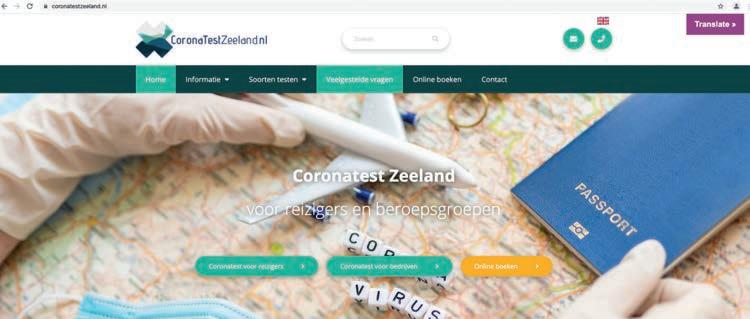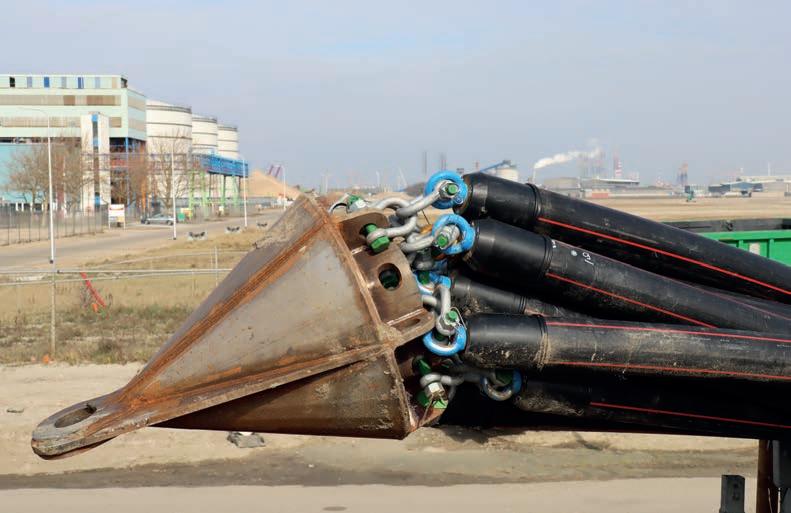
105 minute read
4 8
Through the tubes the actual cables will be laid.
Photo courtesy of Machiel Joosse.
Advertisement
Backbone for energy transition
Verbrugge and C.RO Ports opt for green electricity
The energy transition is one of the strategic key topics at North Sea Port. The port authority and many companies in the port area are taking ample initiatives aimed at a sustainable port. Two energy transition projects recently surpassed the power demand of both companies and resulted in a real technical challenge to supply this surplus to the national grid.
Verbrugge International not long ago announced that 140,000 solar panels will be installed on the roofs of its warehouses in North Sea Port’s Quarleshaven and Scaldiahaven. Apart from Verbrugge, other companies at the Scaldiahaven such as Supermaritime Netherlands will freeride with the project. The amount of PV panels represents a total of 50MW of sustainable power. The solar panels will be installed in collaboration with Kieszon. Today, this project can be considered the largest solar roof project in the Netherlands. At the same time, energy provider Eneco and C.RO Ports have agreed to have fve wind turbines constructed on C.RO Ports’ car terminal at North Sea Port’s Sloehaven. The turbines will contribute 25MW of green electricity.
Considerable amount
The total of 75MW is more than the two terminal operators require for their own use, and therefore the remaining electricity needs to be supplied to the national electricity grid. This is where the challenge of the two projects began. Machiel Joosse, Consultant Energy Transition at Enduris, explains, “Enduris is the network operator for the supply of natural gas and electricity in Zeeland”, Mr Joosse says. “In the summer of 2018, I had just started my new position as consultant, we were confronted with enormous requests for around 160MW of capacity within six weeks. This really is a considerable amount, given the fact that 1MW equals more or less the demand for electricity of
1,000 houses, and a main distribution station can on average handle 40 to 60MW. Part of the 160MW was based on the Verbrugge and C.RO Ports projects, as a large part of the power produced from their solar panels and wind turbines has to be supplied to the national grid.”
Thermphos
For this reason, Enduris had to search for a suitable solution as the existing connections could not be used. Mr Joosse explains, “The surplus of Verbrugge’s Scaldia Terminals at the Scaldiahaven could be supplied to the grid through the Borssele main distribution station (MDS). However, this was not the case for C.RO Ports and Verbrugge’s Zeeland terminal at the Quarleshaven. They are located on the northside of the port area close to the city of Middelburg. A large network of cables exists in the area between the port and Middelburg, leaving little room for additional cables. The Middelburg MDS is already operating at full capacity, leaving no room for the additional electricity from the port area. In our search for a solution, one of my colleagues found out that at the former Thermphos site at North Sea Port, the suitable 30MW MDS-Vlissingen-Oost was out of order and was waiting for decommissioning as part of the Thermphos clean-up projects. We will now give this MDS a ‘second life’and quadruple its total capacity to 120MW.”
Underneath the Sloehaven
In order to lead the electricity from the two terminals to the Thermphos MDS, a new 1.5km long connection had to be made; most of it underneath the port entrance. “When we decided to make use of the MDS-Vlissingen-Oost,” Mr Joosse voices, “we consulted North Sea Port about our plans. For them, the entrance to the port is of course vital, not only now, but also in the future. And due to safety reasons, it was no option to simply lay down the cables on the bottom of the entrance. The best option for everyone was to drill at an appropriate depth underneath the Sloehaven.”

Suffcient margin
Based on future demand for larger vessels to be able to enter the port, it was decided to drill at a depth of 45m to 50m, whereas the maximum draught is currently 17.5m. “Drilling at a depth of 45m, while the current draught for vessels is 17.5m, seems a bit odd, but we had to take the future construction of sheet piles into account”, Mr Joosse states. He continues, “With 45m, we have created a suffcient margin for North Sea Port to keep the draught of the entrance up to date, even when new quays have to be constructed with longer sheet piles. Drilling to the 45m depth within the existing port infra and suprastructure really brought contractor Vulpen close to the technical limits because of the combination of vertical and horizontal drilling. Fortunately, all went well within the planned schedule and without any setbacks, which is truly an achievement everyone could be proud of. I recently saw a picture I took last year of the Pioneering Spirit in the Sloehaven close to the drilling location, and I realised we had to drill as deep as the vessel’s impressive deckheight.”
Photo courtesy of Enduris.
Machiel Joosse, Consultant Energy Transition at Enduris.
In order to lead the electricity Sloehaven from the two terminals to the MDS Vlissingen-Oost a new 1.5km long connection had to be made; most of it underneath the port entrance.

Quarleshaven
Scaldiahaven
Verbrugge’s solarroofs covers 7% of the remaining goals for solarpower for 2030.

Photo courtesy of Verbrugge/Kieszon.
Photo courtesy of Machiel Joosse.
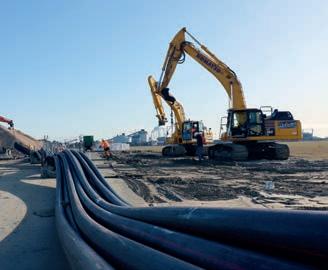
A total of two sets of twelve casing tubes where drilled. Each set has a length of 1,500m, and weighs around 350,000kg.
Electron motorway
A total of two sets of twelve casing tubes where drilled. Each set has a length of 1,500m, and weighs around 350,000kg. “Through the tubes,” Mr Joosse says, “the actual cables will be laid. This underground electron motorway will create an independent circuit for both Verbrugge and C.RO Ports.” Apart from the subsea infrastructure, the MDS-Vlissingen-Oost needs to be updated and a medium voltage hub has been constructed at the Engelandweg. All together, Enduris will be investing around EUR 15 million in the project. “EUR 15 million sounds like a large investment. However, we decided to do so as with this business case, we have simplifed future connections to other companies. Supposing other companies want to supply additional electricity to the network, we can make use of the new strong point for the connection without new expensive and extensive cable laying.”
Balancing is crucial
Apart from the investments of Enduris, transmission system operator (TSO) TenneT invested in the renewal of the existing infrastructure to the MDS-Vlissingen-Oost. Mr Joosse describes the project as the backbone of the energy transition in the Vlissingen port area. “With the investments we made,” he elaborates, “and the excellent collaboration with North Sea Port and other stakeholders such as the municipalities of Borssele and Vlissingen, we have not only contributed to downsizing the ecological footprint of Verbrugge and C.RO Ports. Upgrading the infrastructure and connections for electricity in the port area also creates a robust backbone for the further development of sustainable electricity.” The electrifcation of the port will continue, for example with the plans for electric trucking in the port area. More solar panels and wind turbines will also be installed and the production for green hydrogen will also require more supply of green electricity. “Many sustainable plans will result in a growing demand, together with an increasing supply. However, these will not always be at the same time, so balancing both is crucial in order to prevent the disturbance of the network. With the measures taken, this can be avoided for the upcoming years”, Mr Joosse concludes.
Strong ties
The green electricity from the two recent projects equals the annual use of electricity from 36,000 households. According to the Zeeland Energy Agreement, Verbrugge’s solar roofs cover 7% of the Zeeland Engergy Agreement goals for solar power
for 2030. The Eneco wind turbines at C.RO Ports are equivalent to 16% of the agreement’s wind energy goals. Both projects are recent examples of the initiatives taken by companies to adapt to renewable energy. Verbrugge is also considering the installation of another 60,000 solar panels at its Terneuzen terminals as part of the company’s goals to reduce its ecological footprint. “Verbrugge has strong ties with Zeeland”, says Martin Verbrugge, CEO of Verbrugge. “Many of our employees live here and this way it is obvious that we look after our environment. As a Zeeland family-owned company, we not only care for proft but for welfare, too. By making our acitivies more sustainable wherever possible such as by switching to solar power, we reduce our ecological footprint and contribute to the province’s clean living environment in an economically responsible fashion.”
Climate-conscious
According to Sander Verduijn, Terminal Manager of C.RO Ports, it was not just due to economic reasons that the company decided to have the wind turbines installed on its premises. “As a group, we have for quite a few years been seeking opportunities to use sustainable energy such as wind energy at our Vlissingen terminal. This is a deliberate decision, as with our terminals we have large terrains in industrial environments that are just full of wind, making them highly appropriate for this type of project. When compared with other modalities, including rail transport, transport by vessel has the lowest CO2 emission per tonne of freight. By providing our Ro-Ro terminals with green, locally produced energy, the total amount of CO2 emissions of our operations is reduced to a minimum. With the construction of the wind turbines and soon another fve turbines on our terminal in Zeebrugge (Belgium), we certainly show our eagerness to keep on playing a leading role as an ambitious and climate-conscious terminal operator. And as we got to know Eneco as a provider with the right knowledge and experience, they are the perfect partner for us.” The port area today accounts for almost 300MW of windpower and 150MW of solar energy. This is enough to supply 200,000 households with green electricity. According to Daan Schalck, CEO of North Sea Port, the projects of C.RO Ports and Verbrugge adapt well to the sustainability ambitions of the port authority. “North Sea Port is working on being a sustainable port. In our cross border port, over 400MW is already produced by means of solar and wind power, and this will expand in the upcoming years. The new initiatives of C.RO Ports and Verbrugge demonstrate how companies can make a signifcant contribution to reducing the use of fossil fuels in the port, meanwhile supplying the port’s enviroment with green energy. This is a true win-win situation for everyone”, Mr Schalck states.

I. CROPORTS.COM I. ENDURIS.NL I. VERBRUGGEINTERNATIONAL.COM
Photo courtesy of Machiel Joosse.
The underground electron motorway will create an independent circuit for both Verbrugge and C-RO Ports.
C.RO Ports has large terrains in industrial environments that are just full of wind, making them highly appropriate for wind turbines.
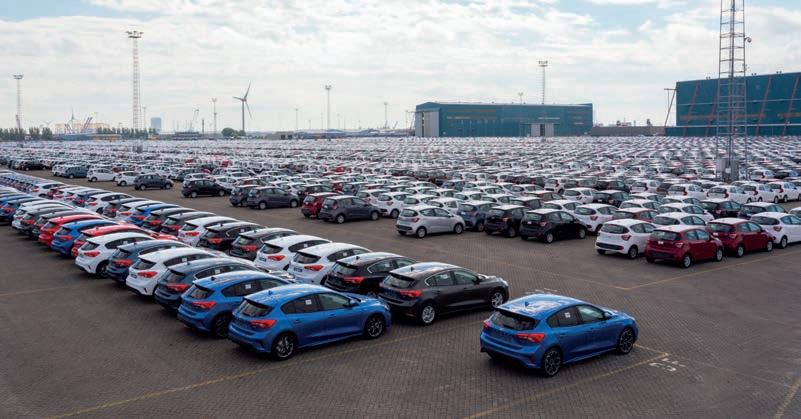
Molymet Belgium enters new markets
PurOx production is in the starting blocks
Photo courtesy of Molymet Belgium.
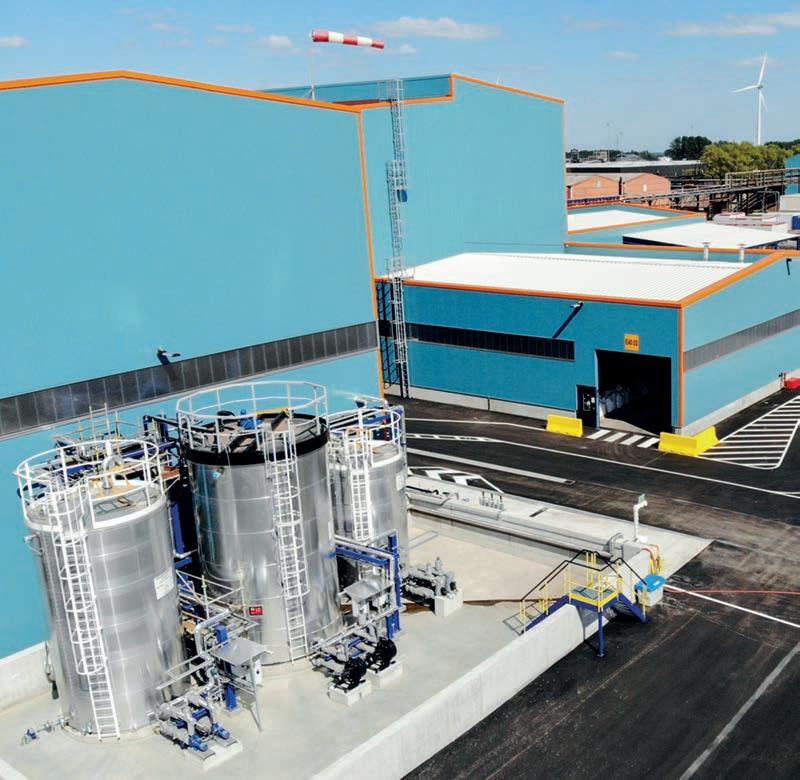
With the new PurOx plant performing its test runs, molybdenum producer Molymet Belgium – formerly known as Sadaci – is preparing itself to expand its production and enter new markets. Adding another layer on top of the long list of investments since the take-over by the namesake Chilean group, this major development also reinforces the company’s sustainability drive by creating an integrated complex and closing a few more loops in the production process.
“With a worldwide consumption of around 600 million pounds, molybdenum (Mo) is very much a niche market. But in this niche, Molymet is big and our plant in Ghent plays an important role in supplying the European market for the iron and steel industry, catalysts, and electronics with this essential component”, explains Godfried Van Schuylenbergh, General Manager of Molymet Belgium and Vice-President Operations Europe in charge of the group’s two European factories, the other one being Molymet Germany in Bitterfeld.
Turning point
He has been with the company for 25 years now and has witnessed its transformation over the last two decades. The year 2003, when the Chilean group Molymet (short for Molybdenos y Metales) acquired full ownership of Sadaci, was a major turning point in the plant’s recent history on the left bank

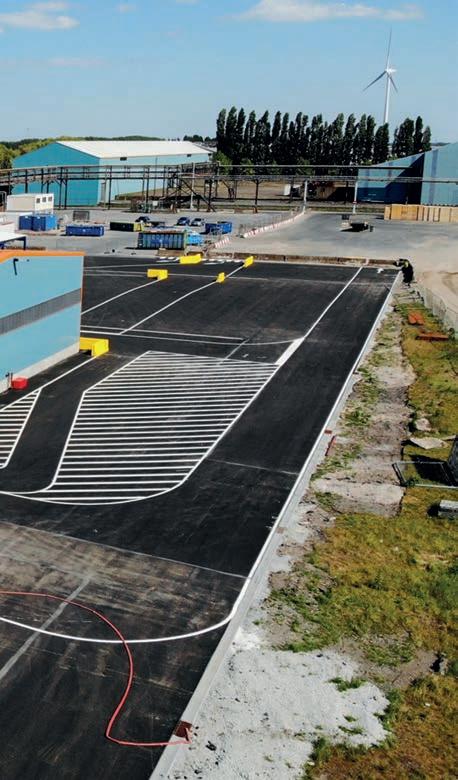
Molymet started building the new PurOx plant in 2017. It is now almost ready to start production. Godfried Van Schuylenbergh, General Manager of Molymet Belgium in front of an aerial view of Molymet Belgium’s industrial site.
We leave the renovation phase to enter a totally new business and market, which is also a way to safeguard our activity and the jobs of our 160 people here in Ghent.
of the canal between Ghent and Terneuzen, he says. “It proved a perfect match for both parties”, Mr Van Schuylenbergh explains. “With the largest processing capacity in the world and an international outreach, Molymet is an undisputed market leader, now accounting for 35% of the global refning capacity for molybdenum (and 70% for
Photo courtesy of Jean-Louis Vandevoorde.
co-product rhenium). Molybdenum is its core business and focus, which was not the case with our previous owners. By acquiring our plant, Molymet gained a strong foothold in Europe and a bridgehead to expand its business on the continent. Ghent has become its third large industrial base, next to the production plants in Chile and Mexico.” But it was a two-way street, adds the General Manager. “Sadaci was an independent molybdenum producer – a rather exceptional position in those days – with a very strong focus on innovation, sustainability, and energy effciency. We had patented several technological applications. We brought them new ideas and approaches that they could beneft from, too.”
Major investments
Molymet almost immediately embarked upon an ambitious investment programme. “They made it clear from the start that they wanted to turn Ghent into a world-class plant for molybdenum. And they defnitely kept their word.” The only other remaining activity, the production of vanadium, was terminated as soon as 2004. “We were too small to make a difference on that market.” The old manganese furnaces, which had stopped burning in the 1990’s, were dismantled. The existing production facilities received a systematic overhaul, with the modernisation of the exhaust gas purifcation system and the renewal of the high and low voltage networks in the factory. “We started planning the building of a new roasting plant in 2007, which was ready in 2011. We expanded this installation in 2016, driving up our production capacity to 35 million pounds a year, about 50% more than the 24 million we had in 2003. Immediately thereafter we opened a new plant to turn Roasted Molybdenum Concentrate (RMC) into briquettes. And in 2017 we launched a 55 million dollar investment in our brand-new PurOx plant.” The change of name from Sadaci to Molymet Belgium at the end of last year, while strengthening the link with the group, also symbolises the process of renewal that the company has gone through since 2003. Along the way, the gloomy and dark plant once overlooking the sea canal has taken on a new and more colourful appearance that refects the new dynamism of the company.
New product
Photo courtesy of Molymet Belgium.
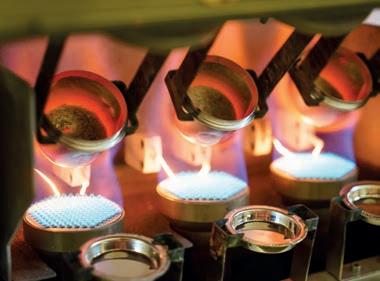
Molymet Belgium produces molybdenum in different grades and qualities. At 99.99%, PurOx is almost as pure as you can get.
Molybdenum: harmless, essential, sustainable, and very useful

Molybdenum (Mo, atomic number 42) is a rather unknown substance, but it is one of the building blocks of life on earth. The non-toxic metal does not exist in a pure form – you will not fnd molybdenum mines as such – and is usually present in only minimal quantities – expressed in grams per ton – in stones, ores, even plants, and in the human body where it contributes to a good functioning metabolism. Molybdenum mainly arises as a by-product of copper mining. It is no coincidence that Molymet is a Chilean company. Chile is by far the world’s leading copper producer. But Molymet, which does not own mines, also buys up molybdenum deriving from copper production in other parts of the world. The long-term contracts with copper producers constitute Molymet’s ‘virtual mine’ for molybdenum. As a raw material, it fnds its way into a large – and increasing – number of applications, from stainless steel, photovoltaic panels, offshore wind turbines, catalysts for desulphurising fuels and exhaust gasses, to electronic devices (touchscreens, smartphones, and tablets) and medication. It is thus part of our daily life and contributes to building a more sustainable society.
It will allow the company to further extend its range of products, complementing the RMC (in powder or briquettes) and the ferromolybdenum (FeMo) it has been making and selling for more than ffty years. It represents a jump forward. Whereas RMC contains at least 57% of molybdenum and ferromolybdenum at least 65%, PurOx is 99.99% pure molybdenum. “We leave the renovation phase to enter a totally new business and market. In our new plant we will turn RMC coming out of our multiple hearth furnace into almost pure molybdenum trioxide. We do that for a reason of course. This product has a higher added value and opens the door to applications such as desulphurisation catalysts, consumer goods like smartphones or displays, medical equipment, offshore windmills, and the likes. This is where the market growth lies. The worldwide market for molybdenum grew by 2.2% last year. In PurOx, the growth rate was twice as high at 4%.” Mr Van Schuylenbergh expects the PurOx plant to be fully operational by the end of the year. The raw material for the new plant will be produced at the Ghent plant and will allow Molymet Belgium to work closer to full capacity, being 35 million pounds of Mo – about 6% of the world total on one site. The mix of products made in Ghent will undergo a substantial change from the present 50/50 proportion between RMC and ferromolybdenum. The general manager expects Molymet Belgium to produce 10 to 12 million pounds of PurOx within a couple of years.
Photo courtesy of Molymet Belgium.
Unique position
“Bringing down the share of RMC, where the added value is limited, and getting into products that increase the margin, like PurOx, is also a way to safeguard our activity and the jobs of our 160 people here in Ghent. Costs are high in Belgium and the competition on the market for more basic products like RMC and FeMo is ferce. We have gone a very long way in saving costs and enhancing productivity, but we have reached our limits there.” With its PurOx division, Molymet Belgium will represent about
In the years since Molymet acquired the company, Molymet Belgium has undergone a major overhaul of its installations, giving the plant a totally new look.
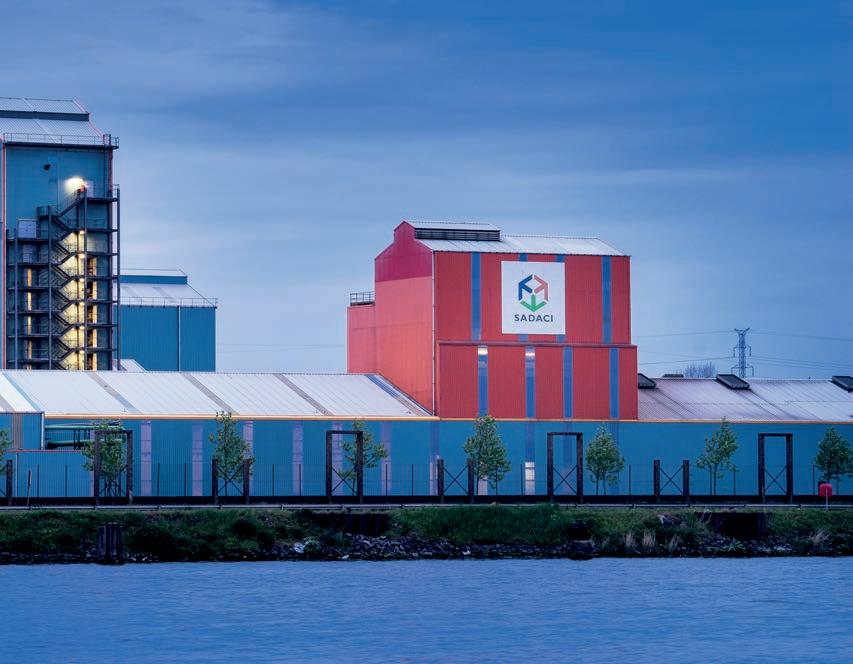
half of the molybdenum production capacity in Europe. But the company’s position will also be strengthened in another way. “The integration of RMC, FeMo, and PurOx on one site is quite unique and offers advantages that our competitors cannot match. We will also be able to rely on ores of a lesser grade, since we purify and reuse them at different stages. As far as molybdenum is concerned, this is the factory of the future.”
Closing loops
“This is also fully in line with the purpose of our company, which is to generate value for the advancement of humanity through products developed by people who believe in the wellbeing of our planet, and hence to pursue sustainability and to contribute to a better environment”, Mr Van Schuylenbergh underlines. “We will do more with comparatively less raw materials, because they will be used to the maximum. By-product fows will be reused in other processes. We will close additional loops by optimising the interaction between our different plants.” “We stick to very high environmental standards and now recycle 98% of our waste and by-products, we do our utmost best to use as little energy and water as possible, and so on. But we are not yet fully satisfed. There are still some residual streams to deal with, and we are planning to build a windmill to provide green electricity to our plant.” With a purity of 99.99%, PurOx is not yet the end of possibilities. “With our 28 hectares, we still have plenty of room left for further developments. There is a ‘Triple 9’ product – meaning 99.999% pure – that we could make as a by-product in our PurOx plant. Here we are talking about very small volumes for very specifc applications. We could look into other activities such as the leaching and purifcation of concentrates. But our priority now is to get our new plant fully operational as soon as possible.” When the time comes for further expansion, the location in a port area might prove useful. “North Sea Port offers an excellent infrastructure and the port authority is always helpful with expertise when needed. We still have a quay on the canal. We have used it in the past to bring in ores with coasters when we were still active in other metals. This is no longer the case today. Our molybdenum ores arrive in big bags in containers that transit through bigger container ports, and we distribute our products mainly by truck. Europe accounts for 95% of our sales, Germany being our largest customer. But we have never given up our quay. You just never know what the future will bring.”
Fifty years Ovet Shipping
This year, Ovet Shipping celebrates its fftieth anniversary. Although COVID-19 keeps the company away from profuse festivities, this does not mean the company is not proud of this achievement, as in half a century the company has grown into an experienced frst-class shipping agency and logistics service provider.
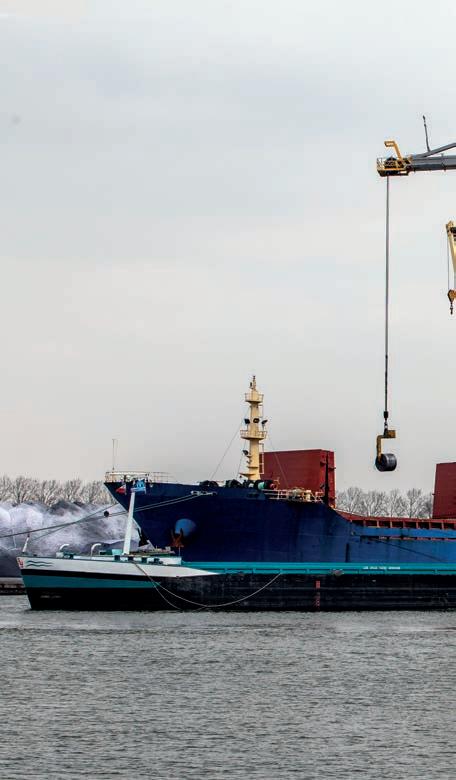
Managing Director Martin Dekker started his career at Ovet Shipping as a boarding clerk and throughout his career he has witnessed over twelve years of the company’s development. “The main activity of Ovet Shipping, with offces located in Terneuzen and Vlissingen, is providing shipping agency services in the Western Scheldt River area”, Mr Dekker explains. “This includes tramp agencies, handling dry and liquid bulk like coal, ore, scrap, chemicals, and liquefed gas, as well as containers and project cargoes, and also husbandry agencies. Next to the services as shipping agent, we are an experienced logistics service provider, taking care of freight forwarding, coastal and deepsea chartering, supply chain services, and offshore services. We are ISO 9001, AEO, and FONASBA-certifed. The combination of these certifcates and an experienced staff guarantees a high service level for our customers 24 hours a day, 365 days a year.”
1957
This broad scope of activities was not yet the case in 1971, the company’s year of establishment. “In fact, our history goes back far beyond 1971”, Mr Dekker says. “In 1957, cargo handler Ovet started business in Terneuzen because of the cokes plant in Sluiskil. Vessels that shipped raw materials for this factory had to be lightered on the Western Scheldt River before they were able to pass the locks on their way to the cokes plant, and Ovet took care of this lighterage. Next to the cargo handling activities, Ovet soon started agency services and in 1971 it was decided to bring those activities together in a joint venture with French shipowner and shipping agency Worms Cie. The company was named Ovet Worms. At a later stage, tanker feet owner Anthony Veder joined and the name changed into Ovet
All photos courtesy of Ovet Shipping.
Worms Veder.” This situation lasted until 1988, when Worms Cie decided to return to its core business and retrieved from all its shipping activities. The company continued under the name Ovet Veder. In 1998, Anthony Veder, like Worms, decided to return to its main activities and sold all of its shipping agencies. Ovet, now remaining as only shareholder, established a new joint venture with Bulk Maritime Agencies under the present name Ovet Shipping. “BMA is part of the Hudig Veder Group, which is located in Rhoon (Rotterdam port area). Hence, Ovet Shipping is now part of an international network of shipping agencies”, Mr Dekker states.
Borssele offshore wind farms
He continues, “As a shipping agency, part of our work still occurs at the terminals of Ovet and at the anchorages at the Western Scheldt River. Apart from this, our work involves a
As a shipping agency, part of our work still occurs at the terminals of Ovet and at the anchorages at the Western Scheldt River.

broad spectrum of other types of cargo and clients. Our focus here lies on dry bulk and tanker vessels, dredgers and vessels for project cargo. Meanwhile we have extended our activities towards logistics services as well. This started in 1996, as a booking agent for Jamaica Shipping. This Jamaican shipping company operated a weekly service from the ARA-range to Kingston and vice versa. And although this specifc line no longer exists, due to the wide variety of different cargo they transported, for example containers, pallets, cars, and also larger objects like trucks, cranes and cargo on project basis, we have built up a lot of knowledge as a liner agent. This enabled us to further expand our role in this.” Acting as shipping agency for project cargo is a relatively new activity for the company, which started when the construction of the Borssele offshore wind farms was announced. “When the tenders for the Borssele wind farms where granted,” Mr Dekker Martin Dekker, Managing Director of Ovet Shipping.

Ovet Shipping’s focus lies on dry bulk and tanker vessels, dredgers and vessels for project cargo.

voices, “we expected a lot of work for local companies, so we approached many of the suppliers who had a part in the construction of the wind farms. For us, it meant that we could take care of a lot of agency work for the vessels that were used to transport and install the turbines close to the Zeeland coast. For arranging materials and goods for the vessels, we made use of local suppliers of much as possible. And although the offshore wind projects near Zeeland are now fnished, the shipping companies involved are aware of our expertise. We hope that we can continue business in this segment, as it is a valuable addition to our work.”
Opportunities
Mr Dekker is also looking forward to the new more sustainable projects announced at North Sea Port. “From a personal point of view, I am convinced that we should all contribute within one’s possibilities to a more sustainable world”, he elaborates. “Apart from this, I know that the many sustainable projects in the port area could be very interesting for us as a shipping agency and logistic service provider from an economic point of view. Take, for example, the development of LPG-fueled vessels and hydrogen plants that are planned to be built in the region.” Mr Dekker still sees a future for bulk though. “It is obvious that demand for coal as fuel will fall, but this does not mean that we will not need coal at all,” he says. “Despite the experiments with carbon-free steel, as it looks now, coal will remain necessary for the upcoming decades for steel production. This also is the case for cokes. Still, we see that our sister company Ovet is looking for products from new segments to handle, such as breakbulk. Also, the ports of Rotterdam and Antwerp are dealing with congestion and North Sea Port is already profting from this, giving ample opportunities for the terminal operators over here. And of course we are capable of playing our role in this as well.”
Mutual interests
Ovet Shipping has always operated in the Western Scheldt River region. Mr Dekker continues, “With BMA as shareholder, it is obvious that we restrict our activities in our region, while the other BMA and Hudig Veder agencies will do the same. This may sound restricting, but this is not the case as it in fact helps us to attract business. When, for example, our colleagues in Rotterdam are contacted for agency services in Zeeland, they will advice them to get in touch with us. Competition at North Sea Port certainly exists with other agencies, albeit most of the time in a constructive way. As we all have to deal with mutual challenges, the majority of Zeeland agencies are a member of the Vereniging van Zeeuwse Cargadoors (editor: the Zeeland Association of Shipping Agencies), of which I am Vice Chairman. This association promotes and protects our mutual interests. In doing so, the association acts as spokesman for pilots, North Sea Port, and customs.

Boarding clerk
Before he became Managing Director two years ago, Mr Dekker played various roles at Ovet Shipping. “Twelve years ago I joined Ovet Shipping as a boarding clerk and through the years I took the opportunities offered by the company. Finally, I became a Managing Director. The good thing of our business is that it gives you the chance to learn a lot”, he says. “Shipping is a very challenging and dynamic industry with a broad range of cargo to be handled and many different roles. This makes our work very diverse. A challenge for all agencies is that it is hard to fnd people that want to become a boarding clerk, like I did twelve years ago. Despite the digitalisation in shipping, the role of the boarding clerk will remain important. Especially as government places a lot of responsibilities in the agencies’ hands, which increases the workload and requires more hands on deck. The young people that follow relevant courses often decide to continue to study at a higher level after graduation. However, personal qualities are perhaps even more important than theoretical knowledge. One should be able to think proactively, be an extrovert, fexible, and responsible. And, as our work is a 24/7 business, you should not mind working irregular schedules. However, in exchange one will have a lot of responsibility, fexibility, and freedom, and you will meet many different cultures on board of vessels. As a boarding clerk, I often got the chance to eat the most exoctic meals with the crew”, Mr Dekker smiles.
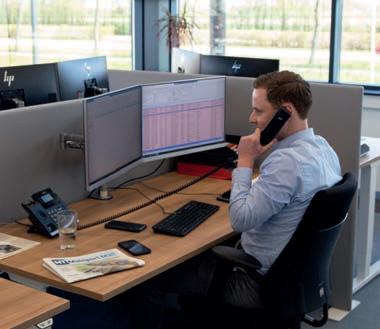
When a problem arises, a shipping agent can shine, and solve the matter hopefully without any delays or extra costs.
People’s business
After more than twelve years, Mr Dekker still enjoys his work at Ovet Shipping. “We are a small team,” he says, “working closely together in an informal way. A downside of working as a shipping agent is that our work sometimes is more or less invisible. The main task of a shipping agency is to make sure all is well arranged for a vessel entering a port. And when all goes well, the ship comes in and leaves without any problems. When a problem arises, a shipping agent can shine, and solve the matter hopefully without any delays or extra costs. The thing I love most in the world of an agency is that it is a real people’s business, both in the operational as in the commercial jobs. With the COVID-19 situation, staying in touch with our customers is now limited, and I am really looking forward to meeting everyone again in person.” COVID-19 was also the reason why Ovet Shipping decided to postpone any kind of festivities concerning the anniversary. “Of course, our intention was to celebrate this unique milestone with everyone, and we hope to be able to at least arrange something for our employees at the end of the year, when hopefully things have turned into a more or less normal mode. To pay attention to 50 years of Ovet Shipping, we decided to update our house style. A new logo was designed and our means of communication such as our website have been updated as well. For 2021, our new logo includes the words Ovet Shipping 50 Years 1971-2021 to mention our anniversary. This phrase will be removed next year when the 51st year of the company will begin, starting our journey towards a next anniversary.”
A challenging work place
Hans Durinck is the new Managing Director of Katoen Natie’s Zeeland Container Terminal – Westerschelde as of 1 May. He is looking forward to this new role at the company he joined in 2018.
Q: Mr Durinck, can you tell us something about your professional background?
A: After graduating in Logistic Engineering at HZ University of Applied Sciences, I started to work for Maersk Line. I was mainly based in Antwerp, but also worked at their Rotterdam offce for a few years. At Maersk I had various roles within the operations and commercial department, starting as Equipment Coordinator to Flow Manager, M & R manager, and fnally CS Export Manager. I went to Katoen Natie to become Commercial Manager Port Operations in 2018. Since January 2020 I have been working as Business Development Manager and since 1 May of this year, I am fulflling my new role as Managing Director of the Zeeland Container Terminal at North Sea Port.
Q: You have always operated in shipping and logistics. Why?
A: Indeed, whilst Maersk Line and Katoen Natie are very different companies, both are operational in the shipping and logistics industry. Throughout the years I have always enjoyed working in these sectors. It is very dynamic and constanly changing. Shipping and logistics are relevant and ever-present. The recent impact of Brexit and the Suez canal incident are just two examples of this. It may be a cliché but without shipping, the economy will soon come to a halt.
Q: Your roots lie in Zeeuws-Vlaanderen, but you have always worked outside of Zeeland. Are you glad to be back?
A: Growing up in East Zeeuws-Vlaanderen, it is hard not to be Antwerp-orientated for cultural and leisure activities. So after fnishing my shipping orientated education, it was somewhat logical that I started working in Antwerp. Now I am older, with a partner and kids, I am more and more aware of the fact that life in Zeeland is very pleasant and has a lot to offer, not only as a place to live but also for work. It is important that this province keeps all the necessary facilities such as education, but also becomes an even more attractive region for businesses. This is necessary for this and future generations. So yes, I am happy to work in Zeeuws-Vlaanderen and I hope to be able to help make the region even stronger. North Sea Port is rapidly growing, which means that shipping is becoming a more stable and important economical pillar for Zeeland, too.
Q: What do you like about working for Katoen Natie?
A: Although operational on a worldwide scale with braches all over the globe in many different sectors from petrochemicals to art, Katoen Natie is still a real Flemish company with a horizontal organisation, short lines, and the capability to act fast when necessary. Next to this, as a provider of a broad scope of value-adding logistics services, Katoen Natie is a challenging work place for everyone with an entrepreneurial spirit.
Q: You have a lot of experience in working for Belgian companies. Do you notice any big differences between people from Belgium and the Netherlands?
A: Belgian people, or Flemish to be more precise, and Dutch people share the same language, but meanwhile there are also lots of differences. This means that one way or the other, you must realise, and adapt to, these cultural differences. This is however not a bad thing and despite,or perhaps even thanks to the differences, I have always enjoyed working in Belgium. Once the initial reservations are gone, you’ll soon fnd the similarities on a personal level.
Q: What do you expect from your new work place?
A: The Zeeland Container Terminal is already an excellent operating terminal. Today’s focus lies on barging products from Dow to the port of Rotterdam and Antwerp. The terminal is located at the Braakmanhaven, with suffcient draught and no locks, which is why I see ample chances for expanding towards other customers and products, as well as to short sea shipping. Around the terminal we have space available for further expansion for handling and storing containers, so this should not hinder any future plans. But frst, I want to get to know all the ins and outs of the terminal and my colleagues there, and I also want to work on my North Sea Port business network.
Q: What do you think of the chances of North Sea Port and Zeeland Container Terminal with regard to short sea shipping?
A: With the large deepsea container ports being more or less controlled by only a small number of large carriers, ports like North Sea Port can proft from feeder services, short sea lines, and niche carriers that have specifc needs for taking care of their shipments. North Sea port has a different value proposition than our surrounding ports. The large container ports such as Rotterdam and Antwerp are facing congestion on roads and inland waterways, which makes them less attractive for certain fows. Since the merger, North Sea Port has been promoting itself as a short sea port, which has already resulted in the expansion of shortsea shipping to and from other terminals. This will help us to expand our services towards this market.
Creating impact for a sustainable future
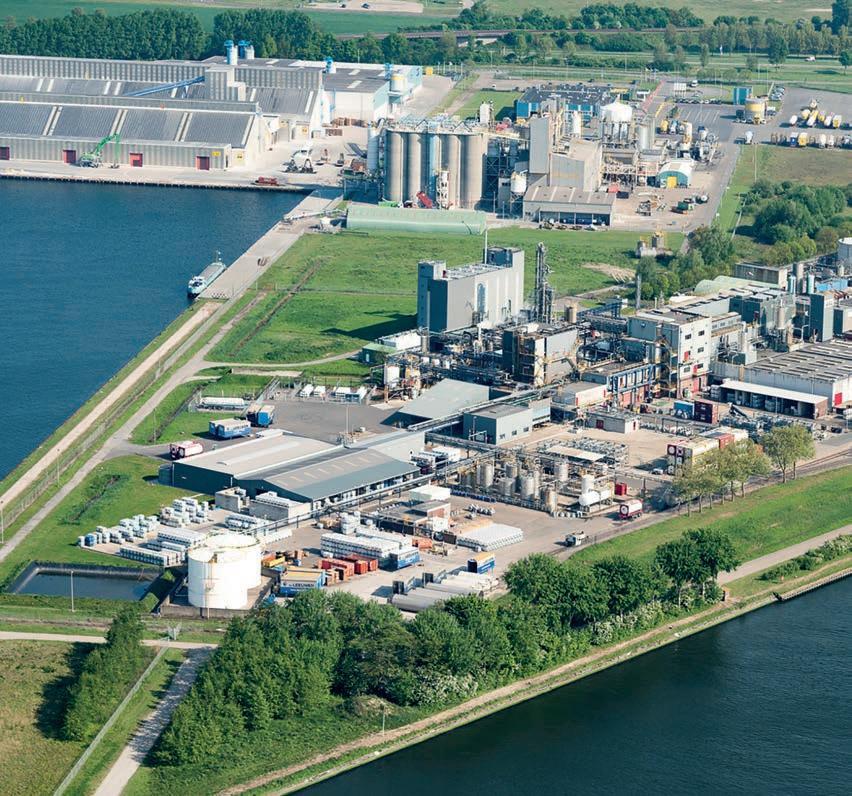
Although the Ghent-Terneuzen Canal has always been a magnet for industrial activities, the development of the Terneuzen part came on stream in the early 1970s when the province of Zeeland started a campaign to attract new business in its fght against unemployment. Several producing companies decided to start new activities in Zeeland. ICL-IP was one of the companies that realised a new plant alongside the canal. PortNews talks with Site Manager Saskia Goole to learn more about the company and its activities.
“Back in the Sixties of the past century, ICL-IP was looking for expansion in Europe for its bromine-based fame retardants”, Ms Goole tells. “Flame retardants are invisible but important products, as they save lives. We always say: ‘No ignition, no fre’, as this is what our fame retardants achieve. In the Netherlands the production of textile was still an important industry in the Twente region, and we decided to start a small offce over there, meanwhile looking for an opportunity to establish a production facility.” A location for this was found in Zeeland, alongside the Ghent-Terneuzen Canal. “We were attracted by the fne facilities in Terneuzen. Of course price was an interesting item, but the excellent rail, road, and waterway connections were important for us, too.”
ICL-IP was one of the companies that in the early 1970s realised a new plant alongside the Ghent-Terneuzen Canal.

All photos courtesy of ICL-IP unless stated otherwise.
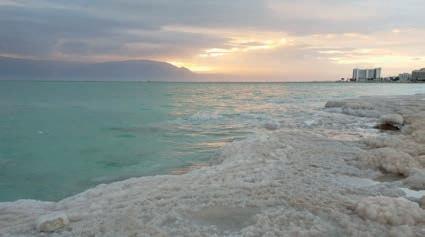
Broad range of products
The company started around 1970 and was named Broomchemie. This name was changed into ICL-IP Terneuzen (IPT) in 2008. “ICL-IP is part of the ICL Group and is the world’s largest producer of elemental bromine. It has various facilities worldwide. ICL-IP stands for Israel Chemicals Limited-Industrial Products. Today in Terneuzen, apart from the fame retardants that are used in a broad range of products such as textiles, insulation for buildings, vehicles, and electronic devices, we produce biocides that are used for industrial water treatment and the paper industry; bromine containing organic products that are used as starting materials and building blocks in the production of pharmaceuticals (medicines, including vaccins), agrochemicals, favours, fragrances, and sunblock UV-flters.”
Energy storage
According to Ms Goole, a relatively new market with ample potential for IPT is energy storage. She explains, “Bromine and bromide compounds form a strong electro-chemical alliance which can be applied for energy storage. For this purpose, we supply electrolytes and bromine complexing agents (BCA). Our products are used in large-scale, stand-alone batteries, thus not for batteries used in cars. Looking at the development of renewable energy from offshore wind, the demand for energy storage is expected to grow fast, so this is an interesting opportunity for us.”
ISO-tanks
Bromine as bromide is present in sea water, natural brines, and salt lake evaporates. All bromine used in Terneuzen is derived from ICL’s evaporation basins and bromine production facilities at the shore of the Dead Sea. “Although bromine can be found at various locations all over the world, we only use bromine from the Dead Sea”, Ms Goole states. “Because of the high concentrates, producing bromine from the Dead Sea is highly cost effcient, which gives us an excellent proposition towards competition.” The product, which at room temperature is liquid and three times as heavy as water, is shipped from Israel to Antwerp in specially built ISO-tanks. From there, it is transported to our plant by truck. With the expanding congestion around Antwerp and the desire to reduce our ecological footprint, trucking obviously is not ideal. We are therefore currently investigating transport by barge and train.”
Bromine recovery
An important second fow of raw material is derived from recycling bromine-containing products. “Our bromine fame retardants are sustainable and circular by nature, and about ffteen years ago we introduced our so-called Bromine Recovery Unit (BRU)”, Ms Goole says. “With this BRU, we can recover bromine from products returning from the market. The unit is
The product is shipped in specially built ISO-tanks.

extremely effcient. It recovers the bromine that fully meets the specifcation needed for the production of fame retardants, and as such contributes to a circular economy.” The BRU fts in IPT’s efforts to reduce its ecological footprint. “Compared to the other process industry in the port area, we only produce a relatively small amount of CO2 and with this in mind, a large contribution to the climate change has already been made. We are continuously seeking further improvements to make our process more sustainable. PV panels can be challenging for a chemical plant, but we still have places on site where they could be safely installed. A modal shift from truck to barge or train would of course highly contribute to our sustainability efforts. One of the base materials used in our process is hydrogen, and it would be interesting for us to step into a small-scale green hydrogen project.”
PolyStyreneLoop
An innovative and sustainable project initiated as co-founder and led by IPT is the so-called PolyStyreneLoop, a cooperation of more than 70 members/supporters of the polystyrene value chain that has built a demo-plant next to IPT. PolyStyreneLoop recycles polystyrene (PS) foam waste containing the fame retardant hexabromocyclododecane (HBCD) previously produced at IPT. A solvent-based purifcation (SBP) process separates HBCD from the PS, allowing the recycling of PS to be used for new insulation materials. The bromine in the HBCD is recovered by IPT’s Bromine Recovery Unit. The bromine is reused to produce new polymeric fame retardant FR-122Ps that is applied in insulation products made from the recyclate Loop-PS. “The PolyStyreneLoop is a demoplant that enables us to achieve a circular production process of fame retardants. We expect that it will work according to plans, and are really looking forward to 16 June when the demoplant will be offcially opened. After succesfully testing the technical and economical feasibility, the process could be upscaled to a commercial scale”, Ms Goole elaborates.
Challenges
When looking at challenges, Ms Goole notices two things in particular: rules & regulations, and recruitment. “Rules and regulations are changing on a regular base,”she says, “meaning that we, our products, and our customers often have to adapt to these changes. This is not necessarily a disadavantage, as we are able to adapt to these changes, but we have to be

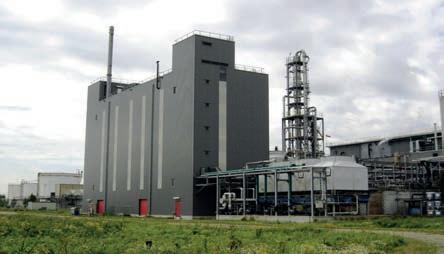
At the Bromine Recovery Unit ICL-IP recovers bromine from products returning from the market.
constantly aware of what is going on. As we have to deal with limited competition, these national or European rules do not necessarily negatively affect our level playing feld, which is often the case for other markets.” According to Ms Goole, a bigger threat is the lack of skilled workers. “In Northwestern Europe, so in our region too, there is a great lack of skilled workers, and technicians are especially hard to fnd. Young people prefer other felds of education and work. A lot of our staff will retire in the upcoming years, and hence we have to fnd proper replacement. Nowadays, we often have to work on fnding the right people. One of the solutions is to collaborate with the various parties concerned in and around the North Sea Port area such as the industry, recruiters, educational institutes, and government.”
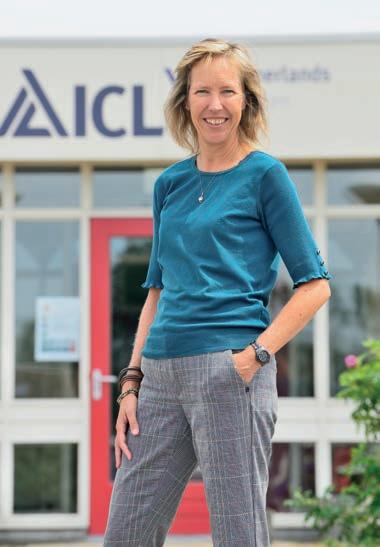
The world of process technology holds few secrets for Saskia Goole, Site Manager of ICL-IP Terneuzen.
Few secrets
The world of process technology holds few secrets for Ms Goole, and she knows exactly what makes working in this industry so attractive. She concludes, “After my study at the TU Eindhoven, I have always worked in process industry. Before joining IPT three and a half years ago, I had been working for various companies (DSM, EPZ and LyondellBasell) for 25 years. At these companies, I experienced a lot by learning and travelling the world. This helps me to understand the technical challenges we are facing here in Terneuzen, and to ask the right questions. This experience helps me to motivate people to do the things they are good at, which makes our company better in so many ways. And whether I like it or not, by working in this industry for so many years, I am a good example of how technology is a good feld for women. Let’s hope this will stimulate female youngsters to opt for a technical career, too.”
The industry in the Flemish-Dutch port area, which includes Yara, ArcelorMittal, DOW, and Zeeland Refnery, has an ambitious roadmap for further reducing its CO2 emissions by 2030 and 2050, and North Sea Port is ready to accelerate towards a climate-neutral port.

With an added value of EUR 12.5 billion, cross-border North Sea Port is among Europe’s Top 3 port areas, offering employment to almost 100,000 people. North Sea Port is one of the fastest growing ports, ambitiously working together with the industry and other stakeholders on sustainability, innovation, and innovative entrepreneurship.
The industry in the Flemish-Dutch port area, which includes Yara, ArcelorMittal, DOW, and Zeeland Refnery, has an ambitious roadmap for further reducing its CO2 emissions by 2030 and 2050, and North Sea Port is ready to accelerate towards a climate-neutral port. This is a challenging and inspiring mission for North Sea Port, one with great developments and high ambitions. For the port authority, this also means that climate ambitions will be combined with economically sustainable growth and related employment. According to CEO Daan Schalck, North Sea Port has in its new strategic plan opted for a circular port. As one of the tangible steps, the port authority in the next fve to ten years wants to dedicate at least 400ha of land to developing and expanding circular initiatives.
Unique cross-border port
North Sea Port is unique in this endeavour, as the port operates cross-border. The seaport is considered as a European pioneering project and so-called experimental region. Flanders and the Netherlands can hence jointly contribute to the further development of sustainable energy. North Sea Port as a circular union, like the European Union strives for in its Green Deal, and all of this in the Union’s logistical heart. North Sea Port closely collaborates with industry and government in the ambitious Smart Delta Resources partnership. This is an international collaboration of energy and raw material intensive industries within the North Sea Port area, aiming at a sustainable future for the industry.
Largest hydrogen region in Benelux
making it one of Europe’s largest hydrogen hubs and the largest hydrogen region of the Benelux. The region sees high potential in phasing out the use of natural gas-based hydrogen consumption and to reduce CO2 emissions. The use of local green hydrogen production plays a vital role in all of this.
Hydrogen Delta Programme
The Hydrogen Delta Programme is SDR’s impressive initiative aiming at large-scale production of green and blue hydrogen. Green hydrogen is fully produced from green sustainable and CO2 emission-free energy, for instance from wind and solar power. In producing blue hydrogen, the emitted CO2 is fully captured and stored in, for example, empty offshore gas felds. Blue hydrogen is therefore also CO2-neutral.
Opportunities for large-scale electrolysis
Research has shown that in the Scheldt-Delta region, North Sea Port is the perfect location for large-scale production and use of green hydrogen. Production and demand for industrial hydrogen has a growth potential of over 1MT per year in 2050. This equals last year’s total Dutch production of hydrogen. Various locations in the port area are suitable for this purpose. The existing and future landing of offshore wind power plays an important role here. As a deep-sea port, North Sea Port has a future as both import and export hub for hydrogen (and any derived molecules such as ammonia and methanol). New sustainable industry will further result in new sustainable activities.
Current hydrogen initiatives
All of this is certainly not just an ambition, as ample projects have already been initiated in the port, including: • The exchange of hydrogen (residual product) between Dow and Yara via a pipeline (Terneuzen) since 2018. • Collaboration between Yara and Ørsted on the construction of a 100MW electrolyser (Terneuzen). • In its H2-Zero project, Zeeland Refnery is realising a 150MW electrolyser (Vlissingen). • Air Liquide has initiated a 200MW electrolyser project (Terneuzen). • VoltH2 is developing two hydrogen projects for the incremental production to 100MW per electrolyser (Terneuzen and Vlissingen). • In Ghent, the North-C-Methanol project will use green hydrogen combined with circular CO2 to produce methanol. • The cross-border SeaH2Land project is announced by Ørsted, aiming at the construction of a large 1GW electrolyser that will be provided with electricity from a new offshore wind farm. A network of pipelines in and outside of the port area will connect demand and supply of the produced hydrogen. • Dow in Terneuzen uses methane-rich residual fows from the cracking processes to produce hydrogen, where CO2 is captured. The current crackers are adjusted to run entirely on hydrogen.
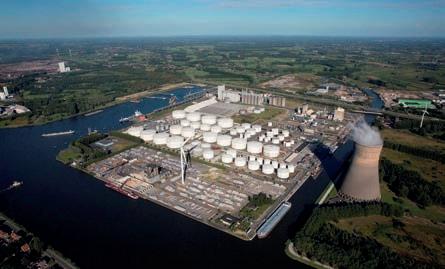
Gateway to Europe
As described above, the cross-border port area is wellsuited for its industry and is conveniently located near various renewable energy facilities. Due to the nearby landing of offshore wind, North Sea Port has direct access to thousands of megawatts of wind energy (wind farms Borssele I & II, III & IV, and soon IJmuiden Ver Alpha). On top of this, the region already has a frst-rate natural gas and 380kV electricity infrastructure in Vlissingen (Sloe area) and Ghent (Rodenhuize). Transmitter system operator TenneT is also investing in, among other things, a converter and a distribution station. There are excellent opportunities for connecting to a national hydrogen backbone and for realising a hydrogen hub in the port area of North Sea Port, because of the interest in the port area from Dutch network operator Gasunie and Belgian gas infrastructure group Fluxys. The port authority, together with the industry and other seaports, is ready to further develop the Flemish-Dutch seaport as hydrogen hub of the Benelux. It is essential that government also invests by using, among other things, the European Recovery Fund, and facilitates in realising the further growth of green energy supply by: • Realising additional offshore wind farms, including infrastructure for landing and distribution. • Investing in hydrogen infrastructure such as pipelines and storage facilities. • Actively contributing to market development. • Financial support of projects contributing to large-scale implementation of green and blue hydrogen. All parties concerned can prepare Belgium and the Netherlands for a hydrogen-rich future as climate-neutral gateway to Europe!
more information
Would you like to know more about North Sea Port or are you interested in collaborating? Please contact: E. publicaffairs@northseaport.com
Raising awareness for a safer work foor

Jonkman Opleidingen has with the mobile training units expanded its capabilities to provide tailor-made inhouse trainings.
Working in a port area is not without risk. A lot of jobs can be dangerous in both logistics and in the producing industry. Incorrect use of tools and equipment and carelessness caused by routine certainly play a role in this. According to Raymond Winterswijk, Managing Director of Jonkman Opleidingen, training and certifcation of people is only part of the solution.
Mr Winterswijk joined Jonkman Opleidingen in January, so he is new to the company. Nevertheless, he has been tried and tested through many years of experience in the feld of industrial services. “In my various roles before joining Jonkman Opleidingen, I have learned that training and safety measures are extremely important in the use of people and recources. At Jonkman I now hope to be able to contribute to a safe working environment for everyone in the industry.”
Variety of courses
Jonkman Opleidingen was founded in 1998. Peter Jonkman noticed a lack of driving experience among the forklift truck drivers at the packaging frm he was working for in those years. His employer granted him permission to organise inhouse driving courses. People from other companies soon followed, and he decided to quit his job and start Jonkman Logistics. After a few years his customers asked him to provide other, non-logistic courses as well. Once Jonkman started to offer a broad range of courses, not just in logistics, it was decided in 2008 to change the name to Jonkman Opleidingen (editor: opleidingen means trainings). “Today, we offer a variety of courses in the feld of for instance SCC, safety, logistics, industrial maintenance & inspection, CERT/frst aid, lifting & rigging, and hot work attendant”, Mr Winterswijk explains.
The Safety Network
Jonkman Opleidingen is a true family company. Although the shares of the Jonkman Family are no longer owned by the family, Roald, the son of founder Peter Jonkman, works for the company as Operations Manager, and Peter only retired in April and was until then highly involved with the company. In 2010, Jonkman Opleiding became part of The Safety Network. An organisation operating in Belgium, Germany, and the Netherlands consisting of seven companies in the feld of safety training, safety advice, and support. The Safety Network today has around 500 employees spread over twelve locations in three countries. The Jonkman Group annually trains around 14,000 people. Although Jonkman still mainly operates in Zeeland, the company has been expanding its market via The Safety Network, and is also active in other parts of the country. “One of the advantages of The Safety Network,” Mr Winterswijk says, “is that through the various companies in the group, we can share and use a lot of knowledge and experience in the entire feld of safety, from policy making to providing frefghting and rescue teams.”

Jonkman Opleiding is currently investigating the options of implementing virtual reality together with a simulator in its ‘Working safely with a forklift truck’ course.
Poor child
Working in logistics and in the industry requires an extensive number of certifcations, for both companies and people. Although companies understand the necessity of this, as it helps to keep work in hazardous operations safe, the certifcation process is sometimes a poor child. “Because of rules and regulations,” Mr Winterswijk states, “the focus for many training centres and employers lies on fast certifcation. Someone who starts tomorrow needs a certifcate today, no matter how. We know there are options to follow a forklift truck driving training online, meaning one will be able to earn a certifcate without having driven this kind of equipment! To me, this feels like getting your sailing permit online without ever being on a boat.”
Things change

Mr Winterswijk continues, “In our opinion, this short-term approach is not the way it should be. It’s like driving a car. The real learning starts when you have your driver’s license and are allowed to drive a car. Throughout the years, things change in traffc: more traffc, more signs, new traffc rules, and so on. Because of this, and because hardly anybody follows some kind of refresher course, accidents in traffc still happen even with the most experienced drivers. Comparable to this, people who want to work in the industry or logistics need all kinds of certifcates, even before they are allowed to enter the premises of a company. People tend to forget that once an employee has earned his or her certifcate, the real learning actually begins. Learning to drive a reach stacker at the training centre during a course is very different compared to actually driving it on a busy terminal, with unexpected things happening every day.”
Dedicated
Since its origin in 1998, Jonkman has built an extended network in its region with many logistic and industrial customers. “We are known for our fexibility and hands-on mentality”, Mr Winterswijk elaborates. “Everyone in our team is very dedicated to teaching our participants. Of course, for obvious reasons we need to help people to obtain the various certifcates based on national and international regulations, for which we need to follow certain script and methods. Other than that, with our many additional trainings we can be more fexible and go a step further, as we really want to help our clients to become better in their work by teaching them how to work as safely as possible and by keeping them aware of unsafe situations at work.”

People tend to forget that once an employee has earned his or her certifcate, the real learning actually begins.
Continuous training
Mr Winterswijk wants to create a continuous learning environment. “We don’t train people for one day, we provide a training for the long term. Instead of providing what I call pulsating trainings, stimulated by the fact that most certifcates require renewal every fve, sometimes even ten years, we promote continuous training with much shorter intervals. We hereby hope to raise the safety awareness of people and
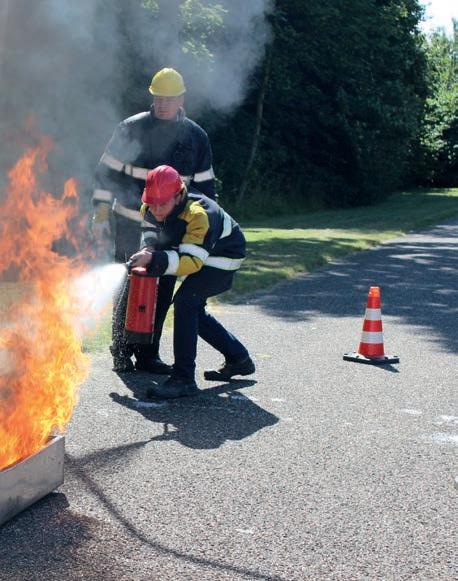
Today, Jonkman Opleidingen offers a variety of courses in the feld of for instance SCC, safety, logistics, industrial maintenance & inspection, CERT/frst aid, lifting & rigging, and hot work attendant.
prevent carelessness often caused by experience and routine. Making people enthusiastic and competent is our goal. We furthermore do not just limit our work to the actual training. We also regularly walk along with employees in their daily routine and with their supervisors too, to learn about their work and to show them how they can improve in the feld of risk reducing and safer working conditions.”
Behaviour-based Safety
For continuous learning, the management of a company also needs to be involved. “Today, safety is too often considered a problem and responsibility of the work foor, which actually is the world turned upside down. Management should also be aware of the risk and safety issues, not just because of the required certifcations and initiated by rules, but also by knowing what is going on on the work foor. For this purpose, Mr Winterswijk aims to apply Behaviour-based Safety (BBS). “BBS is an application of the science of behaviour change to real world safety problems”, he explains. “This will help to create a safety partnership between management and employees that continually focusses people’s attention and actions on their own daily safety behaviour.”
Digitalisation
approach. “The men and women trained by us are usually practically-minded persons. They work with their hands and we are aware of the fact that they prefer to learn by practice, instead of from book-reading and lectures. Various online training courses are offered today that can indeed be helpful in an additional way, especially when they offer some kind of virtual reality, but they will never completely replace real time training. This does not mean we are reluctant towards digitalisation. It can surely help us to improve. We are currently investigating the options of implementing virtual reality together with a simulator in our ‘Working safely with a forklift truck’ course. We are hereby aiming at a frst step in a new way of training. We can of course adapt their roles to changing situations and demand, but in our opinion the instructor and real equipment will always be a part of training. Next to additional e-learning and virtual reality methods, digitalisation can help us to streamline the administrative process. For instance, we digitally provide our participants with their certifcates. This is easy for us, for them, and for their employers, too.”

Raymond Winterswijk, Managing Director of Jonkman Opleidingen.
Useful investment
“Whenever possible, we train people on their own work foor. We have our mobile training units equipped will all necessities to do so. We have with the mobile units expanded our capabilities to provide tailor-made inhouse trainings. This is what our customers ask from us increasingly often. One of our challenges is to convince customers that our methods work. For them, it is an investment they make before any proft, and they want to know if a training is worthwhile. As we know from experience, a training is useless without the right motivation for, and awareness of, safety. We often advise people not to join a training if they lack the right attitude. We hence help companies to invest their money in the right way, making every training worthwhile”, Mr Winterswijk concludes.
More than just a name

Tailormade Logistics
This year, Tailormade Logistics (TML) is celebrating its 25th anniversary. The company led by Bert Vandecaveye has come a long way since it started out as a newcomer in the feld in 1996. It now ranks high among the largest Belgian transport groups. But it does not rest on its laurels, and is still looking ahead.
Bert Vandecaveye laid the foundation of the group in 1996 in a small rented offce in one of the frst warehouses in the Skaldenstraat, which would grow to become the frst big logistics zone in the Ghent port area. “We started out as a freight forwarder with a capital of just 18,000 Belgian francs, a tiny 450 euros when translated into today’s currency. That was the minimum required to set up a company at that time”, he looks back. “The switch to transport and logistics came when Snapper, an American builder of lawn mowers wanting to conquer the European market, asked us to take care of the distribution of their products. The frst years were a constant fght, seven days a week and with only limited margins. But our small team was like a group of friends. Everyone knew everyone and was willing to do his or her utmost best.”
The yellow trucks of TML are a familiar – and very recognizable – sight on the roads.

Photo courtesy of Tailormade Logistics.
TML in a nutshell
• Transport & logistics service provider. • Estimated turnover 2021 of EUR 155 million (28% automotive, 24% fashion, 20% general cargo, 15% fooring, 13% home & garden). • Logistics accounts for 40% of turnover and 50% of
EBITDA, transport for 60% and 40% respectively. • 900 employees. • 320.000m² of dedicated and multi-user warehouse space (not counting the planned expansions). • 20 logistics platforms/cross-docks in Belgium, France,
Sweden, Great-Britain, Italy, and Luxemburg. • 624 trailers, 450 containers, and 305 trucks (excluding the 100 newly ordered vehicles). • In transport: 42% LTL and 34% FTL by road, 22% intermodal, 2% ocean freight. • 100,000 FTL and 1 million LTL per year in international transport, with Belgium, France, Italy, Germany, Sweden, and the UK as main markets. • In distribution: 3,950 fashion store deliveries per week to 850 stores for 55 worldwide brands. • In logistics: 4% repair and waste, 11% tailormade piece picking, 15% reverse logistics, 12% kitting and sequencing, 40% general storage, 18% cross-docking.
A quarter of a century later, Bert Vandecaveye runs Tailormade Logistics from the third foor of his headquarters adjacent to one of the fully-owned warehouses in the Korte Mate in the Hulsdonk zone, just a few hundred metres away from the company’s birth place. Tailormade now ranks 13th among the biggest transport companies in Belgium, is present in seven European countries with twenty logistical platforms and 320,000m² of warehouse space, and has a turnover of EUR 155 million (see box for details). “We now employ about 900 people but as CEO of such a much bigger group, I am more lonely than I was at the beginning. The good thing is the workaholic pur sang I used to be has matured into someone more able to put things into perspective”, Vandecaveye smiles.

The new cross-dock and warehouse in Ghent will be ready in June.

Photo courtesy of Jean-Louis Vandevoorde.
Growing with a vision
From its modest beginnings, Tailormade steadily grew into a more solid player in transport and logistics over the next decade, adding vehicles to its feet and storage space to its infrastructure and reaching a hundred employees. The motor was the spirit that animated the company, the CEO claims. “From the start we knew what we wanted: to think out of the box with our customers and to get out of our comfort zone to create added value, thus generating a competitive advantage for them and us. Tailormade is not just a name, it is our vision and philosophy. There always was a bit of an idealistic dimension to it. You could call us a specialised allrounder making the most of the synergy between transport and logistics. Just-in-time or just-in-sequence, FTL or LTL, B2B or B2C, last mile and city distribution or dedicated line haul, storage or cross dock, racks or bulk, order picking, repack, repair and reuse, reverse logistics… we always adapt to our clients’ needs, try to work out the optimal tailormade solution to meet them, and have a strong focus on service. And state-ofthe-art IT and EDI systems – with real-time information fows and daily stock reports –have always been an essential pillar of our way of doing things, even if logistics remains a people’s business.”
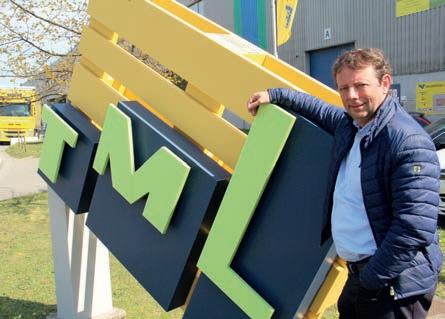
Big jumps and hard times
A frst big jump forward came in 2006, when Tailormade Logistics secured EUR 2 million of fnancial support from an investment fund. True to the asset-based approach of the company, the money was used to heavily invest in rolling stock and its frst own warehouse in Hulsdonk. “That was a good decision in the long term, but proved a noose around our neck in the short run. We had a diffcult moment in 2008.” Another hard time came in 2014. Bert Vandecaveye came back from a period of semi-retirement to steer Tailormade back on the road to proftability. “We had somewhat lost sight of our strategy and values, and were at the brink of tipping over. But in a few months’ time, we were back on track. It is probably the performance I am the most proud of. Since then, we have been able to expand year after year.” By 2017, TML had a turnover of about EUR 40 million and was present in Belgium (where Ghlin and Genk were added as platforms), France, and Sweden. Four acquisitions in 2018 and 2019 provoked a rush to EUR 110 million of turnover and a vast expansion of the group’s network. In little more than a year, Tailormade took over fashion specialist Billiet, fooring transporter KTO, and automotive logistics operators ES&S and Zuiderkempen. “It always takes time to absorb and integrate
Photo courtesy of Jean-Louis Vandevoorde.
Bert Vandecaveye, founder and CEO of Tailormade Logistics.
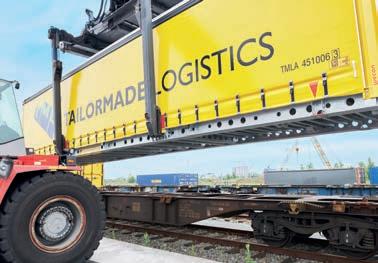
these kind of acquisitions, if only because each company is different and each region has its own culture, but it reinforced our capacity to work in a decentralised manner and it gives us more balance.” It also illustrates another key characteristic of the company: TML does not focus on one particular sector but is active in many felds, which adds to its resilience. With the Brexit, TML also extended its reach to the UK market with a new platform in Rugby. Other countries will be added to the existing list of seven. “Belgium is simply too small to obtain the critical mass you need to generate effciency and productivity gains for the kind of investments we make.”
Investing at full throttle
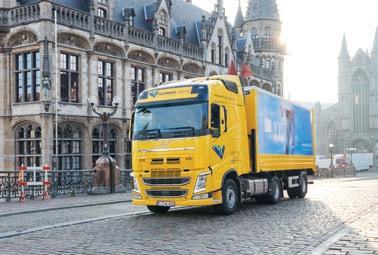
In March and April last year everything pointed in the direction of another heavy storm looming when the frst lockdown due to the COVID-19 pandemic kept stores closed and brought factories to a standstill. The turnover crashed to 20% of its normal level. But the skies cleared up rapidly and despite the many restrictions to economic life, logistics went into a roaring surge. “We are growing at a rate of 20% in France, for instance. And though fashion stores were closed for weeks at a time, we still went up in that market too because new clients came calling.” Tailormade seized the moment to invest heavily. “We are building 60,000m² of warehouse space, 20,000m² each in Ghent, Ghlin, and Westerlo. The new warehouse in Ghent will be split up between 15,000m² of storage room for fashion and lifestyle products and a 5,000m² cross-dock with 50 loading docks. The building should be ready in June.” “We also ordered 100 new vehicles, including smaller trucks for e-commerce and last-mile operations. We started a back-offce in Bulgaria, where some of our collaborators have their home and were stuck due to corona. In Italy, we moved from Mortara to Torino and we will be opening a second antenna in the region of Venice this year. We will start up an ocean freight offce in Antwerp before this summer. And we continue to develop our IT capabilities. In total we are talking about 12 million euros in new investments.” Bert Vandecaveye does not exclude new acquisitions to enter new markets and new countries. In the meantime, he plans to regroup certain operations in Belgium, concentrating them in Ghent and Ghlin, while opening sub-hubs in France.
Looking ahead
Intermodality and sustainability are gaining in importance. Whenever possible, goods are shifted to rail and water. “95% of our volumes to Italy take the train. We also use rail to serve the south of France, Spain, and Eastern Europe. Shortsea is the preferred way to go to the UK and Sweden.” Trucks used in urban distribution for short distances and yard operations are now fuelled by HVO (hydrotreated vegetable oil). “They deliver substantial reductions in emissions of all kinds, without us having to modify our trucks. This fuel is still too expensive for longer hauls though. The aim is to reduce our greenhouse gas emissions by 90% by 2025. The next step will be the switch to electrical and hybrid trucks. We also compensate a lot of our CO2 emissions.” “Our strongest asset for the future is the people that work in our company. Without a strong team, I could never have made Tailormade Logistics what it is today. Putting the right people in the right place and giving them the opportunity to develop their talents is crucial to our success, especially in a decentralised organisation like ours. It creates a unique dynamic, which is enhanced by the fact that our employees come from very varied backgrounds. Their diversity is big. We are a kind of melting pot of diversity, something which can also be said of Ghent.” This trump card could prove helpful when facing the challenges ahead, Bert Vandecaveye concludes. “E-commerce is booming, but we strongly believe concepts like ship-from-shop will help retail hold on to a large share of markets like fashion. We are constantly exploring new possibilities and we expect to continue to grow and double our size again in the coming fve years in Europe and overseas. Our fnancial position is very healthy – our net debt ratio is only 2.6% – and we have the assets to back up our investments and acquisitions. We have the know-how and are willing to take reasonable risks. A new revolution is ahead of us in logistics. Tailormade Logistics is ready to embrace it.”
Photo courtesy of Tailormade Logistics.
TML is a frequent user of rail transportation serving destinations like Italy.
Photo courtesy of Tailormade Logistics.
For city distribution, TML uses vehicles running on HVO, for which it has its own fuel station in Ghent.
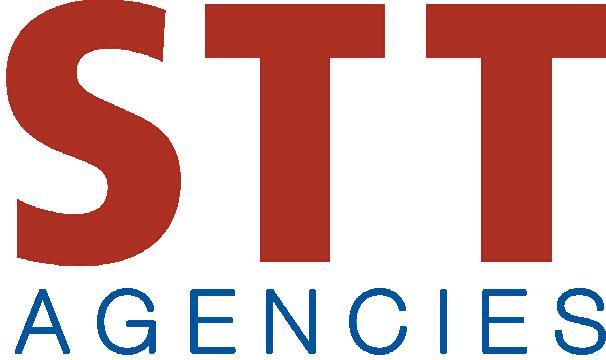
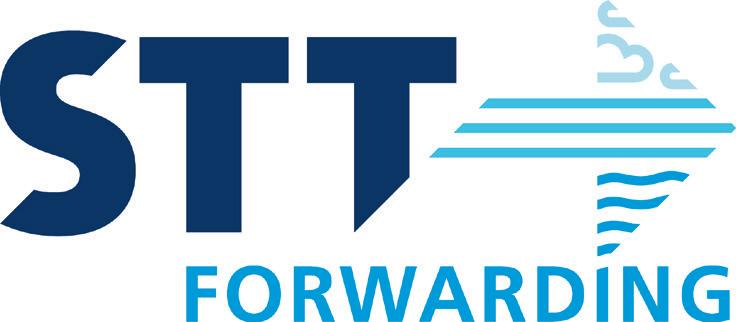
We take care of Maritime & Industrial Worldwide forwarding your logistics cleaning and transport services



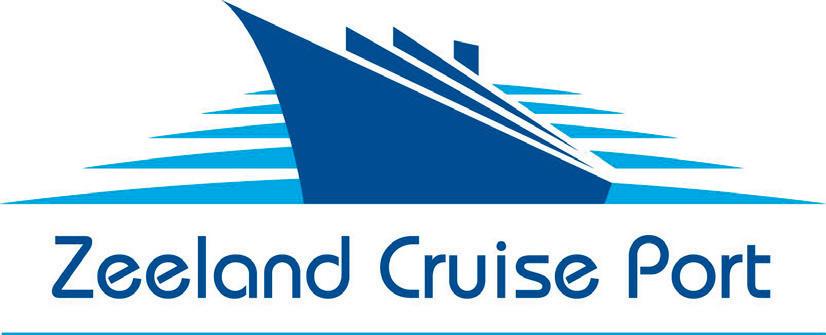
Worldwide forwarding Maritime & Industrial Discover Zeeland, and transport services cleaning the perfect choice for spectacular cruises
Our team guarantees the most cost-effective and feasible solution for your company
Steel with a green certifcate
ArcelorMittal Belgium
With the total make-over of its blast furnace B, ArcelorMittal Belgium has reached a new milestone in its innovation, sustainability, and circularity drive. The largest investment in the history of the Ghent steel plant is part of a much larger approach to achieve the ambitious climate objectives the steel manufacturer is aiming at, explains Geert Van Poelvoorde, the new CEO of ArcelorMittal Europe. Clients can start benefting from these efforts to limit their own ecological footprint by buying steel with a green certifcate.


Geert Van Poelvoorde, CEO of ArcelorMittal Europe.
The four bioreactors for the pioneering Steelanol installation were delivered in March 2021.
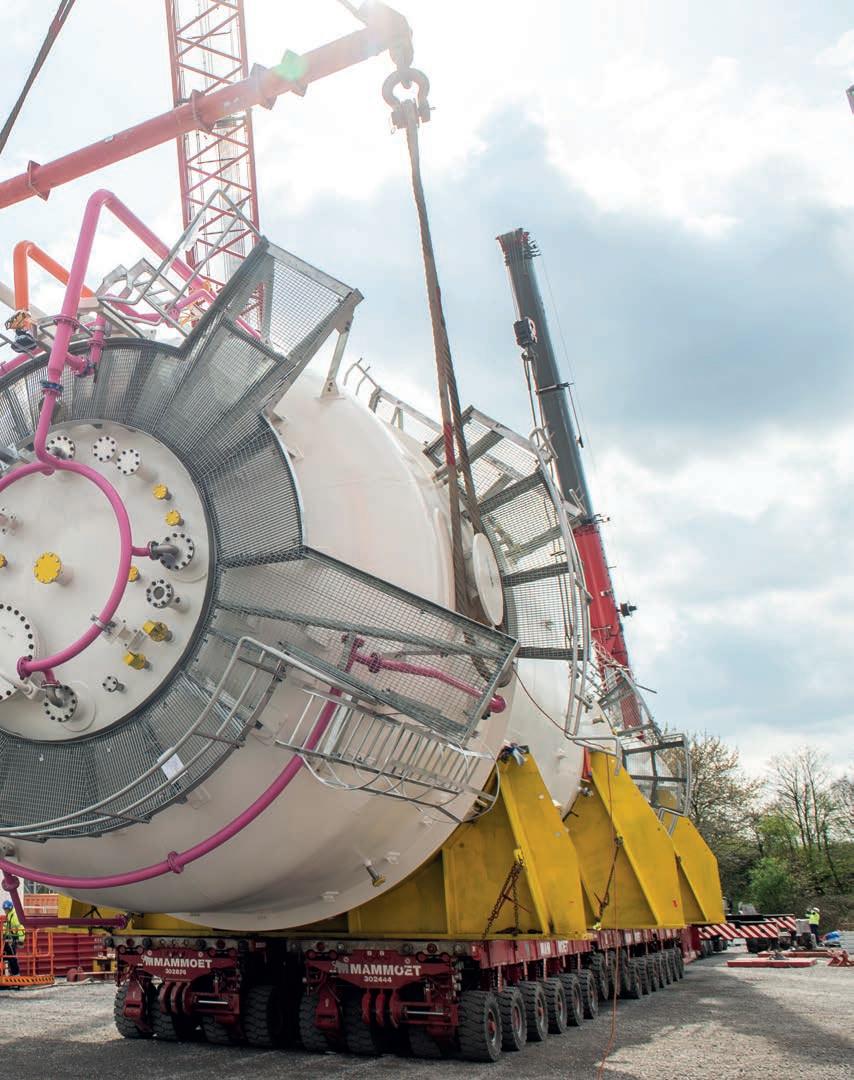
The blast furnace B underwent a total make-over and is now one of the world’s most modern and effcient.

No item ranks higher than decarbonisation on ArcelorMittal’s agenda for the coming years, Mr Van Poelvoorde stresses. “We aim at reducing our CO2 emissions by 30% by 2030 when compared with 2018, and to be climate neutral by 2050. Due to the processes involved in steel making, the challenge for our industry, which emits about 7% of all CO2 worldwide, is gigantic. Achieving these goals will require massive R&D efforts and investments.”
Two routes on the map
In its Climate Action Report published last summer, ArcelorMittal Europe outlines the two routes to advance in the right direction. The ‘smart carbon’ route is the way to go to reduce the input of coal and the output of carbon in blast furnaces by using residual materials (like waste wood, plastics, and gasses) as fuels and turning furnace gasses into building blocks to produce basic chemicals that can be reused. The other route consists of using the DRI technology (direct reduced iron) in combination with an electric arc furnace (EAF). “DRI takes away 70% of the carbon. But at the present time, it runs on natural gas and is thus only commercially viable where natural gas is readily available at an affordable price. This is not the case in Europe. And building a DRI requires an investment of EUR 1 to 1.5 billion, while the steel produced would become completely uncompetitive due to the high gas prices.” Both routes could make use of hydrogen to cut back carbon emissions to almost zero. “The problem is that hydrogen is not yet available in the needed quantities, nor at the right price. Furthermore, we still lack the very large volumes of renewable energies to produce green hydrogen and there is not yet a hydrogen grid comparable to what we have for gas or electricity. A lot of work is being done to make all of this happen, but it will take many more years to get there.” It does not mean nothing can be done in the meantime, the CEO emphasises. “We are exploring all possible options and our plant in Ghent is one of the front-runners in this feld, with its very strong reputation in R&D, productivity, and innovation. Each tonne of steel produced by ArcelorMittal Belgium is already 20% more environment-friendly than steel produced elsewhere in Europe, and 33% more than non-European steel. Compared with 1990, we emit 23% less per tonne today. A lot of projects leading to a further reduction in our emissions are underway (see box). To become carbon-neutral, we will need to shift into a higher gear.”
Green steel certifcate
But clients do not have to wait any longer to take advantage of ArcelorMittal’s improved ecological performances. “For many of them, steel is an important source of ‘Scope 3’ emissions coming from their suppliers. We wanted to pass on our CO2 reductions. Each tonne of steel represents about 2t of CO2. So if we lower our emissions by 100,000t, that can be considered as the equivalent of 50,000t of carbon-neutral steel. We can then deliver 50,000t of steel with a green certifcate that the buyers of our steel can use to limit their Scope 3 emissions. In accordance with the Greenhouse Gas Protocol, the certifcate – which is based on an independent audit and which we sell under the XCarb trademark – refects the gains we have made in lowering our emissions within our whole group and which this system allows us to pass on to our customers.” “For the steel industry, this is a frst. But you can compare it with the green electricity you buy: your provider will have to be able to present renewable energy certifcates to guarantee that the volume of green energy he sold is covered by a corresponding production in renewable energy. It does not mean the electricity you get out of your power plug can be directly traced to a windmill on the North Sea at the other end of the grid. We apply the same principle. But our ambition is, and should be, to produce net zero-carbon steel.”
The frst 30,000t of steel with a green steel certifcate were produced last year. That volume will rise to 120,000t this year, before climbing to 600,000t in 2022. Still a far cry from the volumes needed to reach the 30% target in 2030, but that will require DRI/EAF installations, he adds. “If you build a DRI with a capacity of 2t million, this means 2.8t million of CO2 you can avoid. That is where the big leap forward will have to come from.”
New furnace
“We are more than willing to take up our responsibility and do our part in decarbonising our industry. We are front-runners in this feld, with 1,400 researchers in Europe”, Mr Van Poelvoorde states. “But we need Europe and the Member States to take the right decisions with regard to the Emission Trading System (ETS), with its price for carbon and its free carbon allowances; to regulate the access to the European market for steel that does not bear the same carbon costs and constraints through a Carbon Border Adjustment that creates a level playing feld; and to put into place the funding mechanisms that help us make the transition to low and then to net zero carbon steel happen. If not, we will get carbon leakage, with a big part of the steel industry disappearing in Europe. That would have a dramatic impact on downstream activities and jobs. Europe has everything to gain from taking the lead in decarbonising the steel industry. Setting the example will preserve our economy, give us a technological advantage, and force others to follow.” The message also applies to the future of the steel plant in North Sea Port, he makes clear. “Our blast furnace A will reach the end of its current lifespan by 2025. Relining it like we did with furnace B is not impossible, but is not a futureproof solution. In today’s context, replacing it with a DRI is a better option. It is the one we are exploring in Germany and France in similar situations. We have introduced demands for European aid within the framework of the Hydrogen IPCEI (Important Project of Common European Interest) and both countries are prepared to lend us a hand. We are not that far yet in Belgium. A decision needs to be taken by 2023, which still leaves us a bit of time. But if we want to keep production capacity in Ghent at 5.5t million, we will also need the support of the federal and regional authorities. We cannot do it alone.”
I. BELGIUM.ARCELORMITTAL.COM I. CORPORATE.ARCELORMITTAL.COM
The list of investments made by ArcelorMittal Ghent to optimise its production process, improve effciency, reduce emissions, and increase circularity is getting longer by the day. The plant is spending vast amounts of money in state-of-the-art technology on its way to a greener future, with reduced and low-carbon products as a stepping stone to zero-carbon steel. • The new blast furnace B, now one of the world’s most modern and effcient in terms of productivity, automation, and emissions, costs EUR 195 million. It was inaugurated in early
March. • The Torero installation allowing to use pre-treated waste wood as a fuel to replace coal requires an investment of
EUR 50 million. When commissioned in 2022, it will reduce
CO2 emissions by 225,000t per year. • The Steelanol unit to turn CO into bio-ethanol bears a price tag of EUR 165 million and brings down CO2 emissions by 135,000t a year. It will be up and running next year. • The Calisto project (CArbon dioxide LIquefaction for STOrage) is looking into the possibility to liquefy and store CO2. • The plant participates in the North-C-Methanol and North-
CCU-Hub projects for the production of green methanol and the reuse of CO2. • New windmills and solar panels add to the renewable energy capacity, which already represents 50MW at peak. • The recycling of scrap as raw material – “the easiest way to decarbonise steel” – has been expanded to about 1t million a year. But scrap is in short supply and ‘virgin iron’ remains needed for the high-quality grades of steel produced in
Ghent. ArcelorMittal Belgium is also a very active partner within the cross-border Smart Delta Resources platform. Within this framework it pursues circular synergies with partners within North Sea Port like Dow Terneuzen in projects such as Carbon2Value and Steel2Chemicals. A hydrogen pipeline connecting the two major industrial players in the sea canal area is under examination. The use of the waterway and rail as alternatives to road haulage to make the logistics chain more sustainable has been reinforced over the past years. On a more local level, ArcelorMittal Ghent is developing a heat grid with surrounding communities. The employees contribute to the company’s greening by commuting more often by electrical car or bike. One hundred charging stations (offering 200 charging points) will be installed next year.

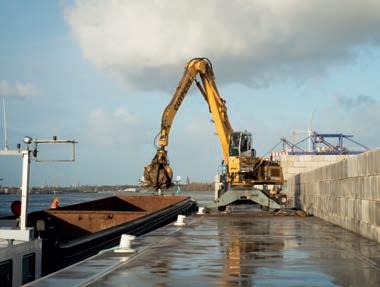
TMS Industrial Services leaves nothing to chance

All photos courtesy of TMS Industrial Services.
As one of the promotors of Maintenance Valuepark, TMS Industrial Services (TMS) in 2017 was one of the frst companies to become operational at this unique location in between Dow Benelux and the Westerscheldetunnel. This was only one of the many steps the company has taken in its continuous growth.
TMS derives from a company established by the Troost Family in 1917 in Pernis (Rotterdam port area). The company started in earth moving and grew rapidly, among other things because of the establishment of the Shell and Esso refneries which resulted in a lot of work for the enterprise. Throughout the 1970s, it also extended its activities towards recycling, environmental services, and steel construction.
Management buy-out
In the 1980s, Troost Group acquired a mechanical services company in Terneuzen that continued business as Troost Mechacon Terneuzen. It also took over two mechanical services companies in Middelburg and Moerdijk in the Nineties. In 2007, caused by a lack of family successors, Troost Group started to search for parties to take over its activities. In 2008,
The 1,000 panels on the roof of TMS’s workshop at MVP Terneuzen can supply around 325,000KW per year.

Marco de Bat, Managing Director of TMS Industrial Services. Vincent de Meester, Location Manager Terneuzen of TMS Industrial Services. Jo Krijn, CFO of TMS Industrial Services.
Marco de Bat, Jo Krijn, Piet Moes, and Carel Jan Reuver, four managers of the Middelburg, Moerdijk, and Terneuzen facilities, came to an agreement with the family of a management buy-out, and TMS Industrial Services was bourne. From the very frst day onwards, TMS had the desire to grow. After a small take-over in 2009, the acquisition of Belgian company ISS Industrial Services followed in 2011. This company was located in Antwerp, Ghent, and Tienen, and its activities ftted perfectly with TMS. At the time of the take-over, Walter Kestens was Director of ISS Industrial Services and joined TMS as the Management Team’s ffth member. Today, four of the fve men, as Mr Reuver left the company in 2016, are still leading the company. To fnd out more, PortNews talks with Jo Krijn (CFO), Marco de Bat (Managing Director), and Vincent de Meester (Location Manager Terneuzen).
According to Mr Krijn, a lot has changed in the market for TMS since the management buy-out. “One of the biggest challenges we had to face,” he says, “was the loss of two of our large customers in the Vlissingen port area just after we acquired TMS. Phosphor producer Thermphos and aluminium plant Zalco gave us a lot of work and this disappeared with their bankruptcy. One of our frst goals was to secure our technicians’ jobs. It forced us to look for opportunities in other regions. We invested in our commercial strength and managed to expand our business in Rotterdam and Moerdijk. However, it is also good to see that nearly all the work we lost in Vlissingen came back to us, because of new companies at North Sea Port.” Throughout the years, TMS has grown into a full range mechanical service provider. “We operate in the feld of mechanical maintenance, repair, and construction”, Mr De Bat explains. “Customers operate in many different industries: powerplants, (petro) chemical industry, tank terminals, food and beverage industry, automotive industry, and so on. Geographically seen, our market is located more or less in between Brussels and Rotterdam, although for dosing systems we operate in the entire Benelux. We operate from seven locations in Belgium and the Netherlands.” “Our services in the feld of dosing systems are relatively new for us,” Mr De Bat continues, “and this is an example of how business often comes to us. Some of our technicians have experience in the maintenance of dosing systems. And when customers in the agri and food market found out about that, they asked us to service their dosing systems along with their other equipment. Another relatively new market for us is the shipbuilding industry, for which we are currently constructing scrubbers.”

TMS Croatia
TMS has a staff of around 700, which often increases to 1,000 in spring and autumn. “Two times per year,” Mr Krijn states, “many customers have a shutdown, giving us a lot of additional work. For this reason, we temporarily hire an additional 200 to 300 technicians.” One of the biggest challenges the company is facing today is to keep the amount of technicians at the required level. Mr Krijn continues, “Like most industry-oriented companies, we are constantly struggling to fnding the right people. Young men and women today prefer other jobs. This is a problem not only we, but the entire Western European area has to deal with. This is why we recently started a business in Croatia. With TMS Croatia, we are now working on extending our team of experienced and skilled technicians for our Belgian and Dutch activities. With TMS Croatia, we have also expanded our maintenance activities in this country. Of course, instead of establishing our own company in Croatia we could have used recruiting agencies, but we preferred to do it this way as the Croation employees are now considered true TMS technicians. This is good for them, and also for our organisation and customers, as like any other employee they share our values and quality standards.”
Maintenance Valuepark
Until a few years ago, TMS Terneuzen operated from two locations. One close to the Terneuzen lock system and, being one of Dow Benelux’s main contractors, TMS also had a workshop at Dow’s contractor park. The company moved to a brand new location at Maintenance Valuepark Terneuzen (MVP Terneuzen) in 2017. “Two things made us realise that we had to look for a new facility in Terneuzen”, Mr De Meester explains. “First of all, Dow, for various reasons, wanted to relocate the existing constractor park from its premises to a location outside but close to their complex. For this, together with the port authority, Dow initiated MVP Terneuzen. Secondly, because of the construction of the new lock near Terneuzen, our location alongside the GhentTerneuzen Canal needed to be demolished. MVP Terneuzen was an excellent opportunity for us to unite all our Terneuzen facilities in one
TMS operates in the feld of mechanical maintenance, repair, and construction.
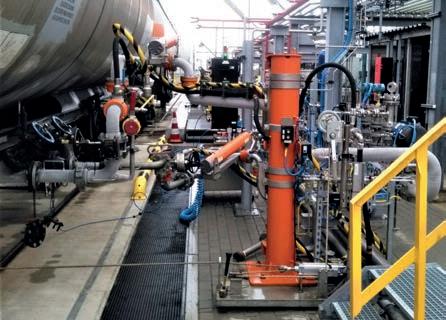
Customers operate in many different industries: powerplants, (petro) chemical industry, tank terminals, food and beverage industry, automotive industry, and so on.
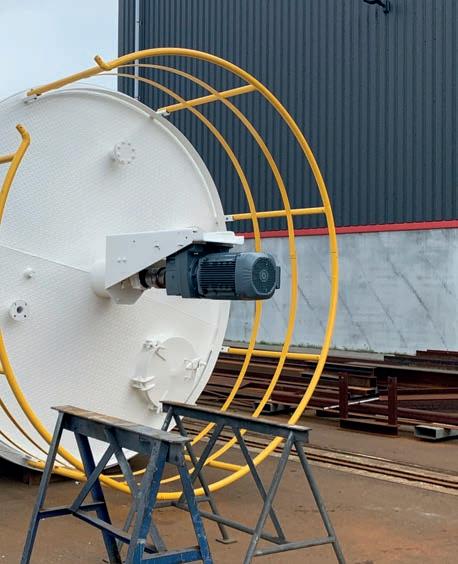

Like most industryoriented companies, TMS is constantly struggling to fnding the right people.
new location. From the start of the project we acknowledged the advantages of the new contractor park, and that is why Pieter Moes became part of the project team.” “At MVP Terneuzen, we now have a brand-new and up-to-date facility with offces, workshop, and storage facility. From here, we can proft from the synergetic advantages of all neighbouring contractors. We are now also close to the Westerscheldetunnel, thus close to the southbound and northbound routes”, Mr Krijn adds.
Solar panels
In realising MVP Terneuzen, ample effort was put into sustainability. “The entire location is free of natural gas as an energy source, and all companies present only use electricity”, Mr De Bat elaborates. “Also, all buildings have high insolation values. Apart from this, as of 2019 all larger companies have to deal with the so-called European EED audits. EED stands for Energy Effciency Directive. Every four years we need to show what measures we have taken to save on the use of energy. When investigating the opportunities to further reduce our demand for power, one of the best solutions was to install solar panels. As we rent our location at MVP Terneuzen from Sagax, we frst had to consult them about our idea. Sagax took over our suggestion and took care of the full realisation. We now have 1,000 panels on the roof of our workshop that can supply around 325,000KW per year. This covers around 65% of our electricity needs. Part of this is used for heating and general use, but most of it is of course needed to power the equipment in our workshop. Sagax is now talking with other tentants at MVP Terneuzen to install solar panels on their roofs too, so our idea could be the beginning of a much larger solar project. By the way, our location at MVP is not the only one with solar panels. Our workshop in Tienen has 1,250 solar panels, which makes it entirely self-supporting with regard to electricity needs.”
Organisational continuity
According to Mr De Meester, TMS looks towards the future with confdence. “We are a lean, horizontal company that can act fast and fexibly. The past years have shown we are capable of expanding into new segments such as the dosing systems and new markets like the shipbuilding industry. With our inhouse expertise, we can offer our customers an extensive package of services. With regard to shutdowns, we can take care of almost all repairs and modifcations. This is great for customers, as they only have to deal with one contact that leaves nothing to chance. It is our intention to further strengthen our position in the market, although we are not necessarily looking to grow our organisation.” “With Mr Moes and myself approaching the end of our working career,” Mr Krijn concludes, “Mr De Meester is gradually given more responsibilities, with Mr De Bat backing him up. We have a loyal team of employees, some of them have been working for our organisation for over 40 years. We always stimulate the internal transfer of people, as this helps us to protect our expertise and knowledge, and to assure our organisational continuity. This approach hase helped us to overcome past challenges, and it surely helps us to keep our healthy position in the market, both now and in the future.”
SeaH2Land – An ambitious hydrogen project
With 580,000t per year, North Sea Port is one of the largest supply and demand centres of fossil hydrogen in Europe today. Driven by decarbonisation efforts, industrial demand in the cluster could grow to about 1,000,000t by 2050. This is equivalent to roughly 10GW of electrolysis.
Ørsted, together with major industrial companies at North Sea Port, recently launched the SeaH2Land vision for a gigawatt scale project to reduce carbon emissions in the Dutch-Flemish industrial cluster by means of using renewable, so-called green, hydrogen. If realised, this will convert approximately 20% of the current fossile hydrogen consumption in the region to renewable hydrogen.
1GW electrolyser
The project includes a renewable hydrogen production facility of 1GW to be developed by Ørsted by 2030. This electrolyser is proposed to link to 2GW of new offshore wind capacity in the Dutch North Sea, as this will enable the large-scale supply of renewable electricity required for the production of green hydrogen. This new wind farm fts well with the ambitions of the
The electrolyser is proposed to link to 2GW of new offshore wind capacity in the Dutch North Sea, as this will enable the large-scale supply of renewable electricity required for the production of green hydrogen.
Dutch authorities for an accelerated offshore wind roll-out in line with increasing electricity demand. The offshore wind farm could be built in one of the zones in the southern part of the Dutch exclusive economic zone already designated to offshore wind development.
Regional ecosystem
Next to the electrolyser and the offshore wind farm, the industrial players in the region, united in the Smart Delta Resources (SDR) industry partnership, will continue the dialogue with TSOs for them to develop a regional open-access pipeline network of about 45km, stretching across the North Sea Port area from Vlissingen (the Netherlands) to Ghent (Belgium). The electrolyser is proposed to link to this pipeline system, hereby connecting large-scale consumption and production in the area. Yara, in consortium with Ørsted, and Zeeland Refnery have each announced plans for mid-size renewable hydrogen production at their sites, while Dow has been exporting hydrogen to Yara since 2018 via the world’s frst conversion of a gas pipeline into hydrogen. The proposed network can be extended further south to ArcelorMittal and further north, underneath the Western Scheldt River, to Zeeland Refnery as a crucial link to create a unique regional ecosystem of hydrogen exchange. This will lead to a signifcant carbon reduction in the manufacturing processes of ammonia, chemicals, and steel. Also, the cluster strategy proposes to extend the 380kV high-voltage network for the electrifcation needs of the industry south of the Western Scheldt River. This would enable GW-sized electrolysis and offshore wind landing zones on both sides of the river, turning the cluster into a true energy hub.
Feeling at home
If realised as envisaged, Ørsted will be in the lead to develop the offshore wind farm and electrolyser. When asking Steven Engels, Managing Director of Ørsted Benelux, about the reason why the Danish company has chosen North Sea Port to develop such a large hydrogen project, he answers, “Because of our Borssele 1&2 offshore wind farm, we have been active in the province of Zeeland now for quite a few years. Collaboration and interaction with all stakeholders has always been very pleasant. We really feel at home and appreciated over here. Furthermore, a lot is happening in the feld of the energy transition in Zeeland, which is perfectly in line with Ørsted’s goals. A few years ago, Ørsted set up a new department focussing on the development of green hydrogen and with Zeeland having such a high demand for hydrogen, it was a logical step to opt for this province as one of the locations to enroll our hydrogen plans. Producing high volumes of green
Hydrogen user
The Hague
New offshore wind farms
Regional infrastructure
Rotterdam
Hydrogen backbone
North Sea
Borssele The Netherlands
Borssele Rotterdam
NL
BE The Netherlands
NL
BE
The fact that Zeeland is close to the North Sea with its many existing and planned offshore wind locations also is a big advantage.
hydrogen requires a suffcient supply of sustainable energy. So the fact that Zeeland is close to the North Sea with its many existing and planned offshore wind locations is another big advantage.”
All signs are green
Although it will take some years before the frst hydrogen will be produced from the new electrolyser, Ørsted’s plans can be realised relatively fast, not in the least because of the space available. “At North Sea Port, all signs for sustainable industry are on green,” Mr Engels continues, “and the port still has ample greenfeld areas available to develop large-scale hydrogen plants. It is obvious that a lot has to be arranged before the actual construction works can start. The decision to announce the plans at the end of March was certainly not without reason, as this was shortly after the Dutch elections for a new parliament. Currently, the forming of a new parliament is underway, and with our announcement we have made clear that our partners such as local government, industry, and port authority and us are willing to participate and invest in our plans. And that despite of this, our plans cannot be realised without the collaboration of the Dutch government. Compared with the hydrogen plants in other Dutch regions, the scale of ours in Zeeland is larger, and what really makes it unique is that it concerns a cross-border project that can act as an example for any other type of European cross-border initiative.”

Start with 500MW
Several locations both north and south of the Western Scheldt River have been identifed for GW-scale electrolysis. Research initiated by Smart Delta Resources – Mr Engels is part of the Board of SDR – demonstrates that a stable amount of green electricity is already available in the region to start a 500MW electrolyser today. “Our frst step,” explains Mr Engels, “is to use this available 500MW capacity. To do so, the necessary network needs to be realised frst. Upgrading to 1GW will require the new to construct offshore wind farm and the possibility
Ørsted’s offshore wind maintenance base in Vlissingen. “We really feel at home and appreciated over here”, says Mr Engels.
Facts & Figures
What is SeaH2Land?
• A 1GW electrolyser to produce renewable hydrogen. • 2GW of new offshore wind capacity linked to the electrolyser. • 45km of regional hydrogen pipelines between the Netherlands and
Belgium to exchange hydrogen between industrial players in the region. • A vision for gigawatt-scale electrolysis and offshore wind landing points on both sides of the Western River Scheldt after extension of the 380kV grid, turning the cluster into a true hydrogen hub.
Who is involved?
• The electrolyser and the offshore wind farm will be developed by
Ørsted. • SeaH2Land is supported by key regional industrial players: Yara,
ArcelorMittal, Dow and Zeeland Refnery. • North Sea Port and industrial players will work with Smart Delta
Resources (SDR) to develop the regional hydrogen network and the 380kV connection to south of the Western Scheldt River. • The project is supported by the Provinces of Zeeland (NL) and Oost-
Vlaanderen (BE).
How and when will the electrolyser be built?
• Phase 1: the frst 500MW can be developed as soon as the required regulatory framework is in place and once development of the envisaged regional hydrogen network allows for it. • Phase 2: the additional 500MW can be developed when the project will be linked to an (inter)national hydrogen backbone. This is expected before 2030. of connecting to a national hydrogen backbone, providing additional fexibility and storage.”
Dialogue with regulatory authorities
According to Mr Engels, one of the most important jobs for Orsted now is to keep in touch with the local, regional, national, and international authorities to bring them into the project. “Our partnership will now move forward,” he says, “and engage in dialogue with the regulatory authorities on the framework and policies needed to support the development of the various parts of our plan. This way, we hope to enroll the project to fnal realisation. Apart from this, a number of pratical things can already be picked up now, like establishing the required regional infrastructure for starting the frst 500MW phase. North Sea Port and SDR will take the lead in this, in close collaboration with the TSOs, supported by the provinces of Zeeland and OostVlaanderen.”
Visor set on 2030
Although it is yet unknown where in the port area the electrolyser will be constructed, it is obvious that the project will generate lots of work for local companies such as contractors and suppliers during construction, as well as when the electrolyser is operational. All of this will create ample new jobs. Mr Engels concludes, “SeaH2Land is a win-win project from many points of view. However, time is ticking and with our visor set on 2030, full pressure must be maintained. We should be able to take the necessary steps towards the actual realisation of our plans in 2022. Or else 2030 will not be a realistic date.”
I. SEAH2LAND.COM
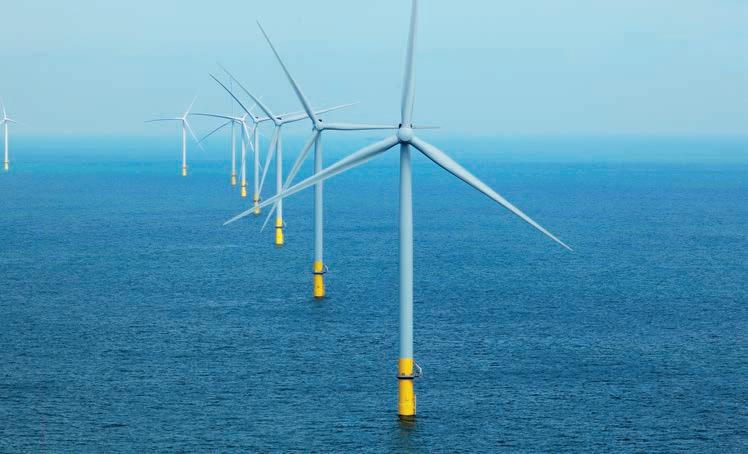
Because of the Borssele 1&2 offshore wind farm Ørsted has been active in the province of Zeeland now for quite a few years.
Photo courtesy of Jean-Louis Vandevoorde.
Luc Geysen, Managing Director of DFDS Logistics Belgium (left) and Jelle Van Koevorden, Managing Director of DFDS Ferry Belgium (right) on the terrace of the new building, overlooking the Ro-Ro terminal at the Mercatordok.

A quiet landmark for a busy terminal
Since the beginning of April, the staff of DFDS Ferry and DFDS Logistics have taken their lodgings in a brand-new offce building at the Ro-Ro terminal on the north side of the Mercatordok in Ghent. One of the busiest terminals in North Sea Port is now run from a modern control tower that offers space for more people and services.
Whoever visited the old DFDS Ferry offces, will be struck by the difference. The old quartres were at the end of their lifecycle. Truck drivers had to cram into a small reception booth to carry out their administrative tasks. Meeting rooms were rather limited, and dock workers were waiting for a more attractive accommodation. The place was a busy one, but in many respects not a very comfortable one. And as the business grew, so did the need for a larger and more modern infrastructure. The new building offers a totally new appearance. Three stories high, it overlooks the terminal and its operations. With 2,000m² of interior space, it hosts the reception and gate teams, a waiting room, canteen, kitchen, and wardrobes with automated lockers on the ground foor. DFDS Logistics is situated on the frst foor, as is fnance. The second foor is the new home of DFDS Ferry, IT, and the customs department. HR has the best spot on the third foor overlooking the port of Gent. A large meeting room plus two terraces can be found on that same foor. Whenever the sun shines, employees can have their lunch there while enjoying the good weather. From here, they will have almost a bird’s perspective of the loading and unloading of
The new offces are a refection of the importance of DFDS in the port activity, the effciency with which the group runs its business, and the attention it has for its people.
ships, trains, and barges, and the incessant fux of trucks and terminal tractors. The new landmark is a proper refection of the importance of DFDS in the port activity, its quiet, unpretentious silhouette, modern lay-out, and state-of-the-art equipment refect the effciency with which the group runs its business, its much improved working conditions, and ample focus on security and safety the care it takes of its staff. About 160 of them – dock workers included – will be making use of its many advantages on a daily basis.
Ferry and Logistics under one roof
The new offce marks another important development. DFDS Ferry and DFDS Logistics, the two main divisions of the Danish operator, have been brought together under one roof. “This will allow us to strengthen the synergies in shared services like fnance, HR, IT, and project management between us on a group level”, explains Jelle Van Koevorden, Managing Director of DFDS Ferry Belgium. “But we will remain commercially neutral when it comes to dealing with our customers and service providers. Sitting next to each other in the same building will not change that.” Luc Geysen, Managing Director of DFDS Logistics Belgium, adds, “Being closer to the terminal and ships helps us to achieve additional effciency gains in combining our door-to-door and intermodal transport activities with our more purely logistical services. But it certainly does not mean we will receive any preferential treatment. The service that Ferry gives to all its customers is perfect for us, too.”
Booming business
With its new offces, DFDS is rounding off the major reconfguration of its terminal in Ghent, which started about 2.5 years ago and has resulted in a further fow optimisation. The old building will disappear in the coming months, opening up additional space for operations. Mr Van Koevorden and Mr Geysen underline that every square metre is welcome, as traffc is rapidly increasing, both in shipping and in logistics. “Despite the corona pandemic, DFDS is doing very well. We recently put a bigger ship on the route between Ghent and Gothenburg. This had the same effect as adding an eighth weekly sailing to our schedule, and this increased capacity is much needed”, explains Mr Van Koevorden. Both gentlemen look forward to throwing a party for the offcial inauguration of their new premises. But they want to wait until the COVID crisis is over. “We have had more than our share of digital meetings and events. This is a terminal where many people come and go. We act with extreme caution in this feld and have implemented very strict rules, even setting up a corona test centre where we encourage our people to have regular tests on a voluntary basis, but preferably as often as possible.”
I. DFDS.COM
The new offces are located next to the terminal. The operational side of the business is still within eyesight.

Green power for transport and industry
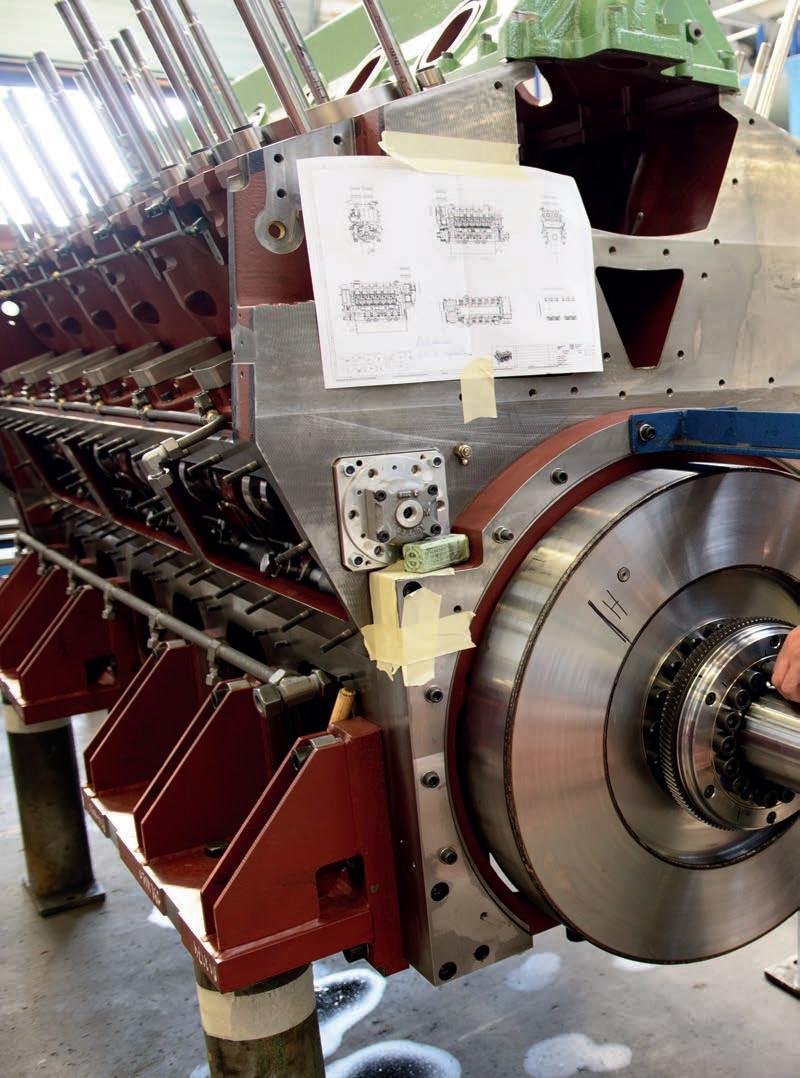
Anglo Belgian Corporation
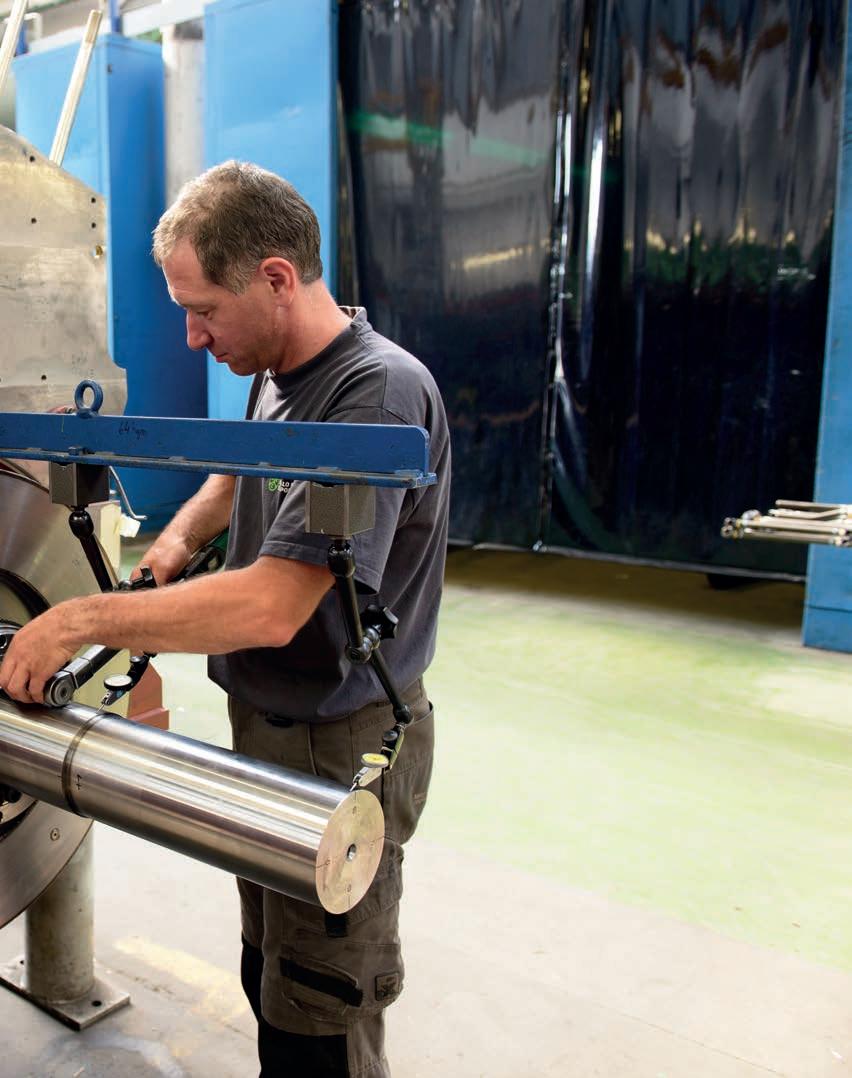
The energy transition is a challenge that forces many companies to rethink the way they produce and move goods. For Anglo Belgian Corporation (ABC), it sits at the very core of their business. The engine builder is developing new power sources to make the green future happen. Its frst zero-emission hydrogen engine will soon hit the market.
ABC has been building engines since 1912 at the Wiedauwkaai in Ghent, in the older part of the port. The medium-speed engines turning at 600 to 1,000 revolutions per minute manufactured by the company can be used for a wide range of heavy-duty applications: marine propulsion and auxiliary gensets for both inland waterway and seagoing ships (from tugboats and offshore service vessels to dredgers and cruise ships), power generation and back-up gensets for all types of utility and industrial purposes, traction for rail locs, special applications like foating cranes and pump sets, and so on. Marine applications represent about 60% of the total annual turnover of EUR 80 to 100 million, but the diversity in markets ensures that the company can more easily absorb dips in one particular segment. Each year between 100 and 200 engines of various types, with a power range from 600 to 10,400kW and presenting an equivalent disparity in sizes and weights, leave the factory where 320 people design and assemble them. No less than 90% is destined for export. Engines bearing the ABC stamp are running on every continent. The company has made its mark, says Tim Berckmoes, CEO of Anglo Belgian Corporation. “We place heavy emphasis on added value, quality, and reliability, as well as on delivering to our customers the tailor-made solutions they require. That is why we do as much as we can ourselves. We have our own casting and machining factories in Belgium, France, and Germany. An ABC engine is a sustainable product that will easily last up to 40 years. The buying price might be a little bit higher, but our engines have much higher effciencies and our customer will save on operational costs due to the lesser need for maintenance and repair. And our engines can be upgraded to meet new emission levels or switch to another fuel.”
Focus on hydrogen
Building upon a century-old history, ABC resolutely looks to the future. “We put a lot of effort into R&D. We are currently investing about EUR 10 million each year in engineering the engines of tomorrow.” Last year ABC took a big step forward when it unveiled its frst dual-fuel diesel-hydrogen engine, developed in the BeHydro 50/50 joint venture with Belgian shipping group CMB. It took three years to develop, but the results are impressive: mainly running on hydrogen, it eliminates 85% of all emissions and thus allows customers to make a jump
Tim Berckmoes, CEO of Anglo Belgian Corporation.
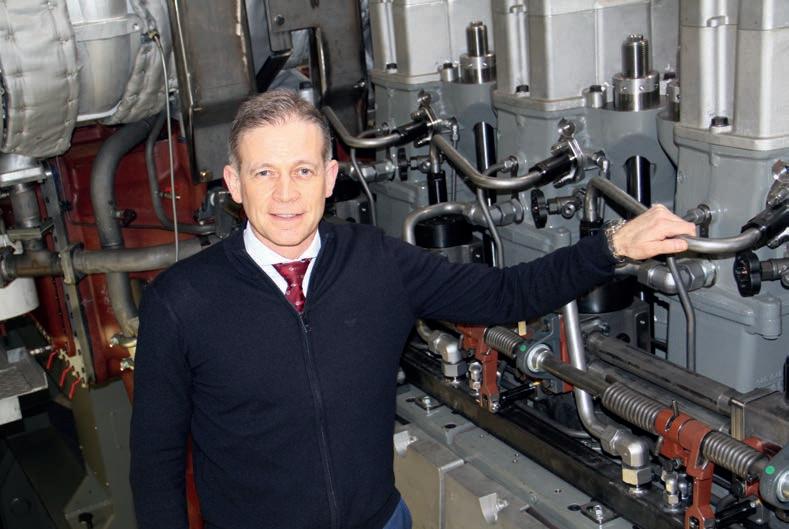
Photo courtesy of Jean-Louis Vandevoorde.
start into greening their power supply. The frst vessels with this propulsion will soon be on the water. The dual-fuel engine will be followed later this year by a 100% hydrogen version, which will be fully zero-emission. “We are testing it right now and will be launching it in the coming months. We have already received our very frst order for a coaster that will operate in Norwegian waters.” Hydrogen is not the only option available at ABC, but it is the spearhead in its fuel strategy. “We have had a multifuel approach for more than 20 years now, and we have engines that can run on almost any fuel. We still make and sell LNG or CNG engines, for instance. And we produce after-treatment systems that take most emissions and particles out of exhaust gasses in line with the most stringent standards. But our main focus now lies on hydrogen and its derivatives like methanol, which are more suited for even heavier applications. Methanol is in the starting blocks. We already have a one-cylinder engine running on this fuel, but its performances are not totally satisfactory yet.” The strategy is also to aim for as fast a transition as possible to zero-emission. “All the in-between solutions can prove useful in the short run, but why invest huge amounts and loads of energy in solutions that will only bring temporary relief? This is where our partnership with CMB is extremely valuable. They are international front-runners in the hydrogen technology, and their many activities in the maritime business offer a lot of opportunities to implement it. Their drive in this feld is hard to match.”

Multifuel future
be multifuel. There will not be a one-fts-all remedy to the challenges of ecology and climate change. Each sector and each application will opt for a specifc fuel that matches its needs in terms of effciency, price, availability, logistics, and the likes.” Hydrogen allows ABC to open up new avenues for what has always been its basic product: the internal combustion engine. “Our 100% hydrogen power system will emit no particulate matter, no nitrogen, no CO, no CO2, only water vapour. This way, the internal combustion engine becomes fully futureproof.” And do not rule diesel out yet, adds Mr Berckmoes. “I do not believe the diesel engine will disappear anytime soon. With the newest after-treatment systems, particle flters, and deNOx catalytic converters, there are almost no emissions left except
Photo courtesy of ABC.
The ABC premises in Ghent will get a major extension.
Photo courtesy of BeHydro.

BeHydro already developed a dual-fuel engine that mainly runs on hydrogen, hereby drastically reducing emissions. A 100% hydrogen, zero-emission engine is coming soon.
for CO2. But if this gas can be captured – and we are certainly not there yet in the marine business – you might fnd yourself in a situation in which the diesel engine could survive, if only because diesel is a fuel that offers a lot of advantages in terms of energy density, availability, bunkering infrastructure, cost, etc.” The CEO of Anglo Belgian Corporation knows the energy transition will not happen overnight. “You not only have to deal with technical issues, but also with economic reality, concerns about safety, problems of storage and distribution, and psychological aspects such as the lack of familiarity with the new technology.” BeHydro eventually hopes to sell 100 to 200 hydrogen engines a year. Mr Berckmoes does not expect to reach this goal within fve years. “Just because the technology is available does not mean that the client, infrastructure, and investments follow at the same pace. A lot of companies have been through diffcult times due to the pandemic.” ABC has fortunately been able to sail through the corona crisis unscathed. “We continued working without interruption and even received a record number of orders. But not everyone has been that lucky.”
Building a case for green urban manufacturing
ABC has secured a major opportunity to grow its business by acquiring an adjacent lot of 5 hectares on the former Vynckier industrial site, right next to its present premises, where the engine builder has reached its maximum expansion. There it will be able to expand its production capacity, yet the ambition of the company reaches even further, as
Mr Berckmoes explains.
“This nearly doubles our total surface. But it’s is not only about fnding more space. We want to turn this new area into a showcase for the possibilities offered by the combination of our hydrogen engine with renewable sources of energy like solar and wind power to achieve the transition to zero-emission manufacturing. We already have solar panels with a capacity of 750kW on our roofs. We would very much like to add a wind turbine to our power generation capabilities. Our hydrogen engines could then play a modulating role by producing energy when the sun doesn’t shine and the wind doesn’t blow. The only thing coming out of the chimneys of the old – and beautiful – Manchester buildings would be water vapour.” At the same time ABC can demonstrate that there is still room for urban manufacturing in a city like Ghent with its rich industrial past. “Living and working in the same area, without having to drive back and forth for miles each day to get to your job, is the way of the future for industry. We have already witnessed that this concept is very attractive to young professionals.” The competition with residential real estate developers for this kind of land is ferce, he adds. “But we have been active on this location for over a century now. And with machines that require very deep and strong foundations, it is not easy to move. We have been given a chance to realise a new industrial destination for the Vynckier site. And we intend to make the most of it.”
Green locomotives
Being located in, or close to, a port the size of North Sea Port is never a bad thing for a company so strongly linked to the marine business, inland navigation, and industry. Mr Berckmoes is convinced that it can also serve as a fne starting base for rolling out hydrogen as an alternative fuel and a lever for greener operations in rail transportation. “Rail is very present in a port like North Sea Port. Almost all terminals have a railway connection and there is a large shunting station right next to the port, which makes fnding bunkering solutions easier. Belgian rail operator NMBS has some 200 locomotives equipped with an ABC engine. We could retroft these perfectly to use hydrogen or methanol as a fuel. We have developed a concept in which diesel tanks in a loc are replaced by hydrogen ones. A hydrogen passenger train is also envisioned for use in the port area. We would certainly welcome this, if only because it would help to create the needed infrastructure.”
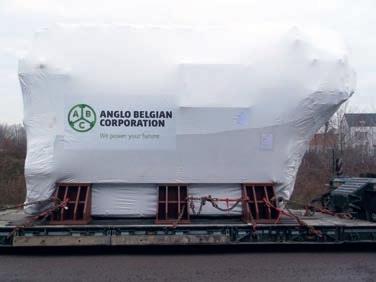
Photo courtesy of ABC.
ABC engines come in many sizes and weights. The largest and heaviest ones require special transport.
For a shipping company, it is obvious that it is important to be hindered as little as possible from COVID-19.
Photo courtesy of Scherp! Fotografe
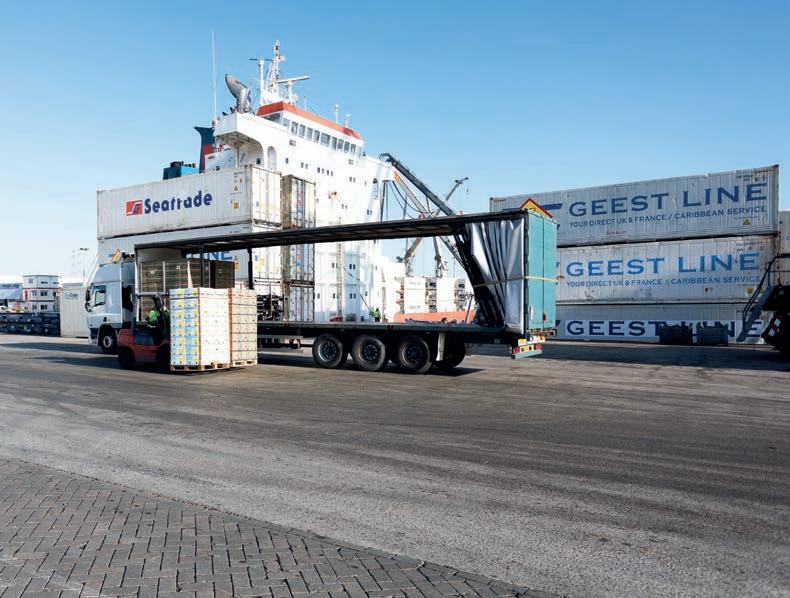
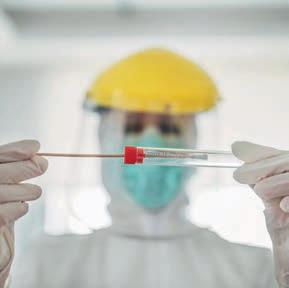
Testing the ship’s crew
COVID-19 has turned our world upside down, with no exception for the maritime industry. Testing and vaccinating on a worldwide scale should help to overcome this pandemic. And although both are picking up pace in Europe, getting tested and vaccinated is certainly not without hindrance for people working at sea.
Dr Wouter van Werkum works as a general practioner at Huisartsenteam Zorg op Zak (editor: General Practice Zorg op Zak). Since the start of the COVID-19 pandemic early last year, his work has become a real challenge as gears are grinding in healthcare now that so many people have become ill. And for Dr Van Werkum, work came from an unexpected angle, too.
Corona Test Zeeland
“Our general practice operates in, among other places, Borssele and ‘s-Heerenhoek, villages that are close to the port area”, Dr Van Werkum says. “My colleague Pieter Ingelse and I are accredited ship doctors, which is why we are often asked for medical assistance in the port area. As soon as the pandemic started, requests came in for testing crews on board of vessels and employees at the terminals and other companies in the port area. In the Netherlands, the largest part of COVID-19 PCR testing is arranged by the GGD (municipal health service), and they are not occupied for testing on location as all testing by them takes place at dedicated test centres that people have to travel to. Because of the demand from terminal operators and shipping agencies, we established Corona
Test Zeeland. We offer high-quality COVID-19 PCR tests, as well as Rapid COVID Antigen tests for employers, crews, and travellers.”
Increasing safety
Dr Van Werkum continues, “With our tests, we can help employees get back to work faster and increase safety in the workplace. Part of the testing takes place in our test centres in Zeeland, although most of the testing occurs on board of the vessels.” Once on board, Dr van Werkum’s work is limited to testing crew members. “We test the crew,” he says, “and if someone appears to test positive for the virus, we will inform the GGD, which will then take over. A general practioner is legally not allowed to judge job-related health matters. When I meet a very ill COVID-19 patient on board, I obviously do not wait for the test results and take immediate action to get the person off the vessel and to a hospital. Though fortunately, this does not happen very often.” For testing a crew, Corona Test Zeeland closely collaborates with Amsterdam-based safebacktowork.com. “When a shipping agent in Zeeland asks us to test someone on board of a vessel that is visiting, for example, the port of Amsterdam, we put them through to them, and vice versa. This helps to raise the effciency and speed of testing. We operate in the North Sea Port area, and they in the Amsterdam-IJmuiden port area. Together, we operate in the port of Rotterdam”, Mr van Werkum states. On board of the vessels, Dr Van Werkum meets different situations that all require different approaches. “Some vessels have a doctor on board, and some don’t. Some have very modern health facilities and other vessels have hardly anything to offer. If someone seems infected with the COVID-19 virus, they are ordered to stay in their cabin and must be tested within fve days. The frst thing I always tell the captain when coming on board is to ensure proper ventilation, as this helps to prevent the virus from spreading around. This can sometimes be a challenge on board of a ship.”

Point of Care testing
A vessel is usually only in a port for a few days, often even for a shorter period of time. “For a shipping company,” explains Dr Van Werkum, “it is obvious that it is important to be hindered as little as possible from COVID-19. And the sooner the test results are known, the better. For this purpose, we are lucky to be in the priority lane of one of the testing laboratories. As a next step, we are, together with Star SHL Laboratories, now introducing a so-called Point of Care PCR testing device. With this device, we can test a person on location and know the result within just 25 minutes. We now have three of these devices, giving us the opportunity to serve shipowners and companies in the port area in a fast, secure and effcient manner. Apart from this, it can also be useful for testing travellers at airports, people travelling by helicopter or crew tenders to offshore platforms, and so on.”
Dr Wouter Van Werkum.
Part of life
It is evident to Dr Van Werkum that the coronavirus will never quite disappear. “We will never realise group immunity, not in the least because of the various mutations and vaccination immunity of virus types. So even if a large population is regularly vaccinated, I expect that testing will remain part of our daily lives. Let us hope we will fnd a mode in which this can be dealt with in a less cumbersome fashion. And with solutions like our Point of Care tester, we hope to be able to contribute to this.”
I. CORONATESTZEELAND.NL
